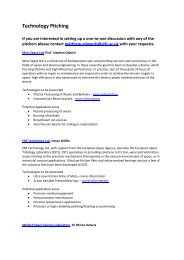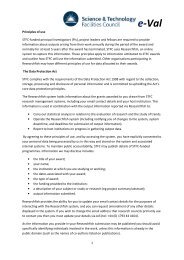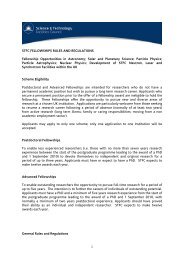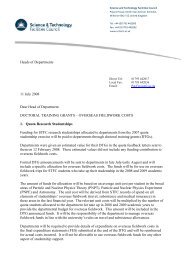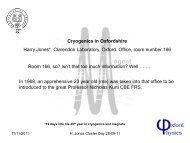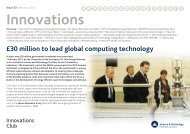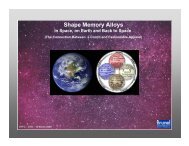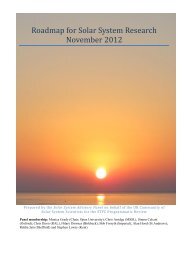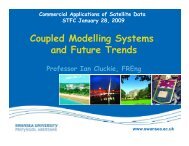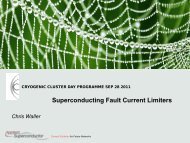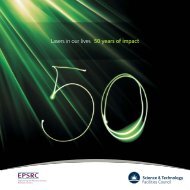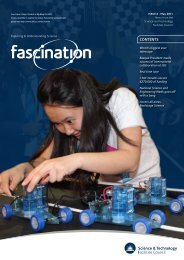RAL Space - latest developments in space science and technology
RAL Space - latest developments in space science and technology
RAL Space - latest developments in space science and technology
You also want an ePaper? Increase the reach of your titles
YUMPU automatically turns print PDFs into web optimized ePapers that Google loves.
<strong>RAL</strong> <strong>Space</strong><br />
Latest <strong>developments</strong> <strong>in</strong><br />
<strong>space</strong> <strong>science</strong> <strong>and</strong> <strong>technology</strong><br />
Council for the Central Laboratory of the Research Councils
CCLRC RUTHERFORD APPLETON LABORATORY<br />
Contacts<br />
General enquiries<br />
Susan Humphreys 01235 445552 s.humphreys@rl.ac.uk<br />
Department Director<br />
Richard Holdaway 01235 445527 r.holdaway@rl.ac.uk<br />
<strong>Space</strong> Physics<br />
Richard Harrison 01235 446884 r.a.harrison@rl.ac.uk<br />
Atmospheric Science/Earth Observation<br />
Chris Mutlow 01235 446525 c.mutlow@rl.ac.uk<br />
<strong>Space</strong> Eng<strong>in</strong>eer<strong>in</strong>g <strong>and</strong> Technology<br />
Richard Crowther 01235 446431 r.crowther@rl.ac.uk<br />
Imag<strong>in</strong>g Systems<br />
Nick Waltham 01235 446500 n.waltham@rl.ac.uk<br />
<strong>Space</strong> Data<br />
Peter Allan 01235 445723 p.m.allan@rl.ac.uk<br />
Radio Propagation<br />
Ken Craig 01235 445134 k.h.craig@rl.ac.uk<br />
Publicity<br />
Jeremy Curtis 01235 446460 w.j.curtis@rl.ac.uk<br />
Market<strong>in</strong>g<br />
John Ellis 01235 445923 j.a.ellis@rl.ac.uk<br />
Messages<br />
Adm<strong>in</strong> office 01235 445111<br />
The <strong>Space</strong> Science <strong>and</strong> Technology Department (SSTD) at CCLRC<br />
Rutherford Appleton Laboratory (<strong>RAL</strong>) carries out an excit<strong>in</strong>g<br />
range of world-class <strong>space</strong> research <strong>and</strong> <strong>technology</strong> development.<br />
With significant <strong>in</strong>volvement <strong>in</strong> over 150 <strong>space</strong> missions, we are<br />
at the very forefront of UK <strong>space</strong> research. Our expertise covers<br />
a wide range of discipl<strong>in</strong>es <strong>in</strong>clud<strong>in</strong>g: astronomy, solar physics,<br />
planetary physics, fundamental physics, earth observation,<br />
atmospheric chemistry, <strong>and</strong> radio propagation. Our eng<strong>in</strong>eer<strong>in</strong>g<br />
discipl<strong>in</strong>es <strong>in</strong>clude <strong>space</strong> electronics, detector systems, thermal<br />
<strong>and</strong> mechanical eng<strong>in</strong>eer<strong>in</strong>g, optics design, software eng<strong>in</strong>eer<strong>in</strong>g<br />
<strong>and</strong> e-Science.<br />
Our 220+ staff are dedicated to support<strong>in</strong>g the programmes of<br />
the Particle Physics <strong>and</strong> Astronomy Research Council (PPARC) <strong>and</strong><br />
the Natural Environment Research Council (NERC), as well as<br />
undertak<strong>in</strong>g a large number of <strong>space</strong> projects for UK <strong>and</strong><br />
overseas agencies, universities, <strong>and</strong> <strong>in</strong>dustrial companies. We are<br />
also a member of the British National <strong>Space</strong> Centre which<br />
coord<strong>in</strong>ates UK civil <strong>space</strong> activities.<br />
We undertake world-lead<strong>in</strong>g <strong>space</strong> research <strong>and</strong> <strong>technology</strong><br />
development, provide <strong>space</strong> test <strong>and</strong> ground-based facilities,<br />
design <strong>and</strong> build <strong>in</strong>struments, analyse <strong>and</strong> process data <strong>and</strong><br />
operate S- <strong>and</strong> X-b<strong>and</strong> ground-station facilities, <strong>and</strong> lead<br />
conceptual studies for future missions. We work with <strong>space</strong> <strong>and</strong><br />
ground-based groups around the world. If you are <strong>in</strong>terested <strong>in</strong><br />
collaborat<strong>in</strong>g with us, please contact of the key people shown<br />
<strong>in</strong> the table below.<br />
Chilbolton Observatory<br />
Reception 01264 860391<br />
Cover: Images from ESA, Stephen Kill (BITD), Earth image<br />
copyright (2005) EUMETSAT.<br />
Editor: Helen Walker assisted by Adam Shaw, Carron Wilson,<br />
Jeremy Curtis.<br />
Richard Holdaway<br />
Director<br />
<strong>RAL</strong> <strong>Space</strong> Science <strong>and</strong> Technology
<strong>RAL</strong> SPACE SCIENCE AND TECHNOLOGY<br />
Rutherford Appleton Laboratory<br />
<strong>Space</strong> Science <strong>and</strong> Technology Department<br />
The Sun 2<br />
Near-Earth environment 4<br />
Earth observation 6<br />
Planetary <strong>science</strong> 8<br />
Astronomy 10<br />
Research 12<br />
Services 16<br />
Design 18<br />
Technology 20<br />
Operations 22<br />
Data management 24<br />
<strong>RAL</strong> <strong>space</strong> missions 26<br />
Staff at <strong>RAL</strong> <strong>Space</strong> Science 28<br />
1
CCLRC RUTHERFORD APPLETON LABORATORY<br />
The Sun<br />
<strong>RAL</strong> has a long heritage of solar <strong>space</strong> mission <strong>in</strong>volvement, ma<strong>in</strong>ly<br />
through the development <strong>and</strong> operation of spectroscopic <strong>in</strong>strumentation<br />
<strong>in</strong> the extreme-UV <strong>and</strong> X-ray wavelengths. We use observations of<br />
the solar atmosphere to determ<strong>in</strong>e plasma characteristics of the solar<br />
atmosphere.<br />
SOHO STEREO SOLAR-B<br />
Launched <strong>in</strong> 1995, the ESA/NASA<br />
Solar <strong>and</strong> Heliospheric Observatory<br />
(SOHO) is the world’s largest solar<br />
physics <strong>space</strong> mission <strong>and</strong> it has<br />
revolutionised our underst<strong>and</strong><strong>in</strong>g of<br />
the Sun. <strong>RAL</strong>’s Coronal Diagnostic<br />
Spectrometer (CDS) is a unique<br />
<strong>in</strong>strument, designed to detect solar<br />
extreme ultraviolet radiation which<br />
allows us to probe conditions <strong>in</strong> the<br />
solar corona. The spectra recorded by<br />
CDS provide <strong>in</strong>formation on<br />
temperature, density, elemental<br />
composition <strong>and</strong> flows of very hot<br />
plasma trapped <strong>in</strong> the Sun’s magnetic<br />
field. The CDS operation is run from<br />
<strong>RAL</strong>, where the requests for<br />
observations from a user community<br />
of 15 UK <strong>in</strong>stitutes <strong>and</strong> over 50 worldwide<br />
groups are coord<strong>in</strong>ated, planned<br />
<strong>and</strong> run. CDS has enabled the<br />
discovery of a number of phenomena,<br />
<strong>in</strong>clud<strong>in</strong>g rotat<strong>in</strong>g columns of plasma<br />
that resemble tornadoes <strong>and</strong> the fact<br />
that the Sun’s atmosphere is riddled<br />
with Earth-sized explosions known<br />
as bl<strong>in</strong>kers.<br />
Contact: Andrzej Fludra<br />
Tel. 01235 445679<br />
E-mail: a.fludra@rl.ac.uk<br />
solar.bnsc.rl.ac.uk/<br />
The Sun occasionally ejects vast gas<br />
clouds <strong>in</strong>to <strong>space</strong>. Known as coronal<br />
mass ejections (CMEs), each cloud<br />
may carry 1,000,000,000 tonnes of<br />
gas <strong>in</strong>to <strong>space</strong> at several hundred<br />
km/s. When these clouds engulf Earth<br />
they can disrupt power, navigation,<br />
communication <strong>and</strong> satellite control<br />
systems. The NASA STEREO mission,<br />
due for launch <strong>in</strong> 2006, will send two<br />
identical <strong>space</strong>craft <strong>in</strong>to Earth-like<br />
orbits, one ahead <strong>and</strong> one lagg<strong>in</strong>g the<br />
Earth, from where they can look back<br />
at both the Earth <strong>and</strong> Sun, <strong>and</strong> detect<br />
CMEs as they approach Earth. All of<br />
the imager <strong>and</strong> coronagraph<br />
<strong>in</strong>struments on each <strong>space</strong>craft will<br />
use a novel CCD-based camera system<br />
developed by <strong>RAL</strong>. In addition <strong>RAL</strong><br />
provides the scientific lead for the UK’s<br />
Heliospheric Imager on STEREO.<br />
Contact: Richard Harrison<br />
Tel. 01235 446884<br />
E-mail: r.harrison@rl.ac.uk<br />
The Solar-B mission is an Earthorbit<strong>in</strong>g<br />
Japanese <strong>space</strong>craft, due for<br />
launch <strong>in</strong> 2006, whose payload is<br />
be<strong>in</strong>g provided by Japanese, American<br />
<strong>and</strong> British groups. Build<strong>in</strong>g on the<br />
highly successful SOHO <strong>and</strong> Yohkoh<br />
solar missions, Solar-B will carry<br />
imagers which can map the magnetic<br />
fields of the solar surface as well as<br />
the structure <strong>and</strong> evolution of the<br />
different layers of the solar<br />
atmosphere with unprecedented highresolution.<br />
The Extreme-ultraviolet<br />
Imag<strong>in</strong>g Spectrometer (EIS) is be<strong>in</strong>g<br />
built by an <strong>in</strong>ternational consortium<br />
led by the Mullard <strong>Space</strong> Science<br />
Laboratory. EIS measures spectral<br />
emission l<strong>in</strong>es <strong>in</strong> order to derive solar<br />
plasma diagnostic <strong>in</strong>formation, at a<br />
pixel size of 750 km on the solar<br />
surface. <strong>RAL</strong> is a key player <strong>in</strong> the<br />
EIS consortium, provid<strong>in</strong>g assembly,<br />
<strong>in</strong>tegration <strong>and</strong> test facilities, with<br />
particular responsibility for cleanl<strong>in</strong>ess<br />
<strong>and</strong> contam<strong>in</strong>ation control. <strong>RAL</strong> is also<br />
responsible for the vital radiometric<br />
calibration of EIS <strong>and</strong> for software for<br />
operations plann<strong>in</strong>g <strong>and</strong> support.<br />
Contact: Jim Lang<br />
Tel. 01235 446365<br />
E-mail: j.lang@rl.ac.uk<br />
SOHO/CDS, NASA, ESA<br />
Enormous loops of gas at 400,000 K break away<br />
from the Sun<br />
ESA<br />
Left: An artist’s impression of Solar Orbiter<br />
Background: SOHO/EIT image of a solar<br />
prom<strong>in</strong>ence erupt<strong>in</strong>g<br />
NASA, ESA<br />
2
<strong>RAL</strong> SPACE SCIENCE AND TECHNOLOGY<br />
SOHO <strong>space</strong>craft NASA, ESA<br />
SOLAR ORBITER<br />
SOLAR DYNAMICS<br />
OBSERVATORY<br />
Solar Orbiter was selected by ESA <strong>in</strong><br />
September 2000 with a proposal led<br />
by the Max Planck Institute for<br />
Aeronomy <strong>and</strong> <strong>RAL</strong>. The mission<br />
makes use of solar electric propulsion<br />
<strong>and</strong> planetary fly-bys (Venus <strong>and</strong><br />
Earth) to achieve a 150-day orbit with<br />
a perihelion of 40 solar radii, <strong>and</strong> thus<br />
makes numerous close encounters of<br />
the Sun. Repeated Venus fly-bys, on<br />
every third orbit, will allow the<br />
<strong>space</strong>craft to climb out of the ecliptic,<br />
provid<strong>in</strong>g the first high latitude<br />
observations of the solar atmosphere<br />
– extremely valuable for studies of the<br />
high-speed polar w<strong>in</strong>d outflows, the<br />
solar dynamo, global mass ejection<br />
processes <strong>and</strong> global irradiance. The<br />
mission is now <strong>in</strong> a study phase <strong>and</strong> is<br />
due for launch <strong>in</strong> 2013. <strong>RAL</strong> is lead<strong>in</strong>g<br />
a consortium to build a highresolution<br />
UV spectrometer/imager for<br />
the mission.<br />
Contact: Richard Harrison<br />
Tel. 01235 446884<br />
E-mail: r.harrison@rl.ac.uk<br />
www.orbiter.rl.ac.uk/<br />
SDO is NASA’s first <strong>Space</strong> Weather<br />
Research Network mission <strong>in</strong> the<br />
Liv<strong>in</strong>g With a Star programme. It is<br />
designed to study solar atmospheric<br />
structures <strong>and</strong> magnetic fields from<br />
their emergence at the surface <strong>in</strong>to<br />
the corona, us<strong>in</strong>g a set of imag<strong>in</strong>g<br />
systems <strong>in</strong> the UV, extreme-UV <strong>and</strong><br />
visible light, <strong>in</strong>clud<strong>in</strong>g magnetic<br />
mapp<strong>in</strong>g us<strong>in</strong>g the Zeeman effect.<br />
SDO is due for launch <strong>in</strong> April 2008<br />
<strong>and</strong> will be <strong>in</strong> a geosynchronous orbit.<br />
The emphasis on high-resolution<br />
imag<strong>in</strong>g results <strong>in</strong> a data rate of<br />
140 Mbps. <strong>RAL</strong> has a contract with<br />
Lockheed Mart<strong>in</strong> Advanced<br />
Technology Center to provide the<br />
CCD camera electronics boxes for two<br />
of the three scientific <strong>in</strong>struments on<br />
SDO. In addition, <strong>RAL</strong> has scientific<br />
<strong>in</strong>terest through a co-<strong>in</strong>vestigator role<br />
<strong>and</strong> is heavily <strong>in</strong>volved <strong>in</strong> preparation<br />
for receipt of high data-rate data,<br />
automated analysis, <strong>and</strong> storage of<br />
data for UK scientists.<br />
Contact: Andrzej Fludra<br />
Tel. 01235 445679<br />
E-mail: a.fludra@rl.ac.uk<br />
SOHO/EIT images<br />
of erupt<strong>in</strong>g solar<br />
prom<strong>in</strong>ences<br />
NASA, ESA<br />
<strong>RAL</strong> has been <strong>in</strong>volved <strong>in</strong> scientific missions<br />
to study the Sun for over 25 years<br />
3
CCLRC RUTHERFORD APPLETON LABORATORY<br />
Near-Earth environment<br />
A wonderful natural laboratory for study<strong>in</strong>g fundamental phenomena <strong>in</strong><br />
the physics of plasmas (ionised gases). Our scientists study these us<strong>in</strong>g<br />
<strong>space</strong>-based <strong>and</strong> ground-based <strong>in</strong>struments. These phenomena are of<br />
great <strong>in</strong>terest <strong>in</strong> underst<strong>and</strong><strong>in</strong>g <strong>space</strong> weather.<br />
Earth as seen by MSG<br />
© 2005 EUMETSAT<br />
ACE<br />
The <strong>RAL</strong> Ground Station receives data<br />
from the American Advanced<br />
Composition Explorer (ACE) satellite,<br />
located 1.5 million kilometres from<br />
Earth <strong>in</strong> the direction of the Sun.<br />
The satellite measures the particles<br />
<strong>and</strong> magnetic fields <strong>in</strong> the solar w<strong>in</strong>d,<br />
enabl<strong>in</strong>g scientists to predict<br />
electromagnetic events that could<br />
disrupt satellite or ground-based<br />
communications systems. The data<br />
gathered at <strong>RAL</strong> are sent to the NOAA<br />
<strong>Space</strong> Environment Center <strong>in</strong> the USA<br />
for process<strong>in</strong>g, <strong>and</strong> the results can be<br />
viewed at http://sec.noaa.gov/ace/.<br />
Contact: John Wright<br />
Tel: 01235 445809<br />
Email: j.s.wright@rl.ac.uk<br />
www.ralgroundstation.rl.ac.uk/<br />
ACE <strong>space</strong>craft NASA<br />
Gas clouds ejected from the sun <strong>and</strong> travell<strong>in</strong>g at hundreds<br />
km/s can engulf Earth, disrupt<strong>in</strong>g power, navigation,<br />
communication <strong>and</strong> satellite control systems<br />
4
<strong>RAL</strong> SPACE SCIENCE AND TECHNOLOGY<br />
CLUSTER II<br />
Cluster II is an ESA mission,<br />
revolutionis<strong>in</strong>g our underst<strong>and</strong><strong>in</strong>g of<br />
the <strong>in</strong>teraction between electrically<br />
charged particles from the Sun <strong>and</strong><br />
the Earth’s magnetic field. The four<br />
Cluster <strong>space</strong>craft were launched <strong>in</strong><br />
pairs on 16 July <strong>and</strong> 9 August 2000<br />
<strong>and</strong> now orbit the Earth <strong>in</strong> formation.<br />
This unique set of multi-po<strong>in</strong>t<br />
measurements allows us to study, for<br />
the first time, the three-dimensional<br />
structure of the fundamental physical<br />
processes occurr<strong>in</strong>g <strong>in</strong> the near-Earth<br />
environment as they vary with time.<br />
The second mission extension will start<br />
<strong>in</strong> 2006 <strong>and</strong> will make use of new<br />
multi-scale formations <strong>and</strong> sampl<strong>in</strong>g<br />
of regions not previously covered. <strong>RAL</strong><br />
has a major hardware <strong>in</strong>volvement <strong>in</strong><br />
two of the <strong>in</strong>struments: RAPID<br />
measures the energetic ions <strong>and</strong><br />
electrons, while PEACE measures the<br />
lower energy electrons. <strong>RAL</strong> runs ESA’s<br />
Cluster Jo<strong>in</strong>t Satellite Operations<br />
Centre which has responsibility for<br />
plann<strong>in</strong>g <strong>and</strong> comm<strong>and</strong><strong>in</strong>g the<br />
<strong>in</strong>ternational <strong>science</strong> operations.<br />
The UK Cluster Data Centre is located<br />
at <strong>RAL</strong> <strong>and</strong> provides <strong>science</strong> data<br />
process<strong>in</strong>g <strong>and</strong> dissem<strong>in</strong>ation facilities<br />
for the national Cluster community<br />
<strong>and</strong> is also responsible for the<br />
technical development of ESA’s Cluster<br />
Active Archive. <strong>RAL</strong> scientists play a<br />
lead<strong>in</strong>g role <strong>in</strong> the <strong>science</strong> exploitation<br />
from the mission <strong>and</strong> <strong>in</strong> coord<strong>in</strong>at<strong>in</strong>g<br />
activities with ground-based<br />
<strong>in</strong>strumentation such as EISCAT<br />
(see page 7).<br />
Foreground: Three of the four CLUSTER <strong>space</strong>craft<br />
ESA<br />
Background: TRACE image of coronal loop<br />
NASA<br />
Contact: Chris Perry<br />
Tel: 01235 445780<br />
Email: c.h.perry@rl.ac.uk<br />
www.cluster.rl.ac.uk/<br />
5
CCLRC RUTHERFORD APPLETON LABORATORY<br />
Earth observation<br />
Mak<strong>in</strong>g observations of the l<strong>and</strong>, sea <strong>and</strong> air from <strong>space</strong> allows scientists to<br />
develop <strong>and</strong> improve their models of our environment. <strong>Space</strong> <strong>in</strong>struments<br />
provide cont<strong>in</strong>uous, global measurements for many years at a time allow<strong>in</strong>g<br />
events like El Niño to be studied.<br />
EARTHSHINE<br />
IONOSPHERIC<br />
MONITORING<br />
MSG (GERB)<br />
Astrium UK<br />
An artist’s impression of EARTHSHINE<br />
The EARTH-Sun-Heliosphere-<br />
Interactions Experiment is a multidiscipl<strong>in</strong>ary,<br />
<strong>in</strong>ter-discipl<strong>in</strong>ary mission<br />
which will provide vital new data on<br />
how the Sun <strong>in</strong>fluences Earth’s <strong>space</strong><br />
environment <strong>and</strong> climate.<br />
EARTHSHINE will be able to monitor<br />
the photon, particle <strong>and</strong> magnetic<br />
outputs of the Sun, <strong>and</strong> study how<br />
they <strong>in</strong>fluence the power that Earth<br />
reflects back <strong>in</strong>to <strong>space</strong>. EARTHSHINE<br />
will tell us much about the formation<br />
<strong>and</strong> effects of clouds, about the global<br />
electric circuit, the solar w<strong>in</strong>d, <strong>and</strong><br />
how solar <strong>and</strong> heliospheric magnetic<br />
fields form <strong>and</strong> evolve.<br />
Contact: Mike Lockwood<br />
Tel: 01235 446496<br />
Email: m.lockwood@rl.ac.uk<br />
<strong>RAL</strong> carries out rout<strong>in</strong>e monitor<strong>in</strong>g of<br />
the Earth’s ionosphere from<br />
Oxfordshire <strong>and</strong> the Falkl<strong>and</strong> Isl<strong>and</strong>s.<br />
These stations provide the longest<br />
sequences of ionospheric data <strong>in</strong> their<br />
respective hemispheres <strong>and</strong> set the<br />
world st<strong>and</strong>ard for data quality. The<br />
data are used <strong>in</strong> a wide variety of<br />
<strong>science</strong> areas, from radio<br />
communications to climate change.<br />
Contact: Sarah James<br />
Tel: 01235 446579<br />
Email: s.f.james@rl.ac.uk<br />
www.ionospheric-monitor<strong>in</strong>g.rl.ac.uk/<br />
ENVISAT<br />
ESA’s ENVIronmental monitor<strong>in</strong>g<br />
SATellite was successfully launched on<br />
1 March 2002. It carries the AATSR<br />
<strong>in</strong>strument – the third <strong>in</strong> the Along<br />
Track Scann<strong>in</strong>g Radiometers (ATSR)<br />
series. AATSR monitors global sea<br />
surface temperatures with an accuracy<br />
of 0.3 C for climate study purposes.<br />
<strong>RAL</strong> provided subsystems <strong>and</strong><br />
laboratory calibration, <strong>and</strong> also the<br />
reference data process<strong>in</strong>g system.<br />
MIPAS, an <strong>in</strong>frared spectrometer,<br />
measures pressure, temperature <strong>and</strong><br />
trace gases such as ozone from 6 km<br />
to 70 km <strong>in</strong> the atmosphere. <strong>RAL</strong><br />
provided the low vibration cooler<br />
electronics.<br />
Contact: Chris Mutlow<br />
Tel: 01235 446525<br />
Email: c.t.mutlow@rl.ac.uk<br />
www.atsr.rl.ac.uk/<br />
Scientists are us<strong>in</strong>g observations from <strong>space</strong><br />
to underst<strong>and</strong> if the complex <strong>in</strong>teractions<br />
between the Sun <strong>and</strong> Earth’s atmosphere<br />
affect global warm<strong>in</strong>g<br />
The Geostationary Earth Radiation<br />
Budget series of <strong>in</strong>struments monitor<br />
the reflected sunlight <strong>and</strong> thermal<br />
emission from Earth, to study daily<br />
variations <strong>and</strong> long-term climate<br />
changes. There are four <strong>in</strong>struments <strong>in</strong><br />
the series: three have been completed<br />
by a European consortium led by <strong>RAL</strong><br />
<strong>and</strong> the fourth is currently be<strong>in</strong>g<br />
manufactured. GERB-1 was launched<br />
<strong>in</strong>to geo-synchronous orbit on the first<br />
of EUMETSAT’s METEOSAT Second<br />
Generation Satellites (MSG-1) on<br />
28 August 2002. MSG-2, with<br />
GERB-2, is planned for launch <strong>in</strong> June<br />
2005. This will meet EUMETSAT’s<br />
requirement to have two of the MSG<br />
satellites <strong>in</strong> orbit at any time, one<br />
Check<strong>in</strong>g GERB at <strong>RAL</strong><br />
provid<strong>in</strong>g the operational service <strong>and</strong><br />
the other act<strong>in</strong>g as a reserve. The four<br />
satellites scan the Earth roughly every<br />
three m<strong>in</strong>utes <strong>and</strong> are designed to<br />
provide a service for more than<br />
15 years. <strong>RAL</strong> has also developed <strong>and</strong><br />
operates a major part of the GERB<br />
ground segment, receiv<strong>in</strong>g data from<br />
the <strong>in</strong>strument <strong>in</strong> near real-time,<br />
process<strong>in</strong>g <strong>and</strong> archiv<strong>in</strong>g it.<br />
Contact: Cormac Neeson<br />
Tel: 01235 446435<br />
Email: c.g.neeson@rl.ac.uk<br />
www.sstd.rl.ac.uk/gerb/<br />
6
<strong>RAL</strong> SPACE SCIENCE AND TECHNOLOGY<br />
TOPSAT under test <strong>in</strong> a clean room at <strong>RAL</strong><br />
EISCAT<br />
TOPSAT<br />
SUPPORTING GALILEO<br />
The European Incoherent SCATter<br />
facility consists of three radar systems<br />
<strong>in</strong> Northern Sc<strong>and</strong><strong>in</strong>avia which studies<br />
the ionosphere, the ionised region of<br />
the Earth's atmosphere. At high<br />
latitudes the Earth's magnetic field<br />
l<strong>in</strong>es extend outwards from the<br />
ionosphere <strong>in</strong>to regions of the<br />
magnetosphere which <strong>in</strong>teract strongly<br />
with the solar w<strong>in</strong>d, so that EISCAT<br />
can observe many important solarterrestrial<br />
coupl<strong>in</strong>g processes. Major<br />
<strong>science</strong> themes <strong>in</strong>clude the study of<br />
energy coupl<strong>in</strong>g from the Sun to the<br />
Earth's plasma environment, with<br />
coord<strong>in</strong>ated observations with Cluster<br />
(p.5). An <strong>in</strong>creas<strong>in</strong>g emphasis is placed<br />
A high-resolution optical camera is<br />
be<strong>in</strong>g developed for the TopSat<br />
programme, produc<strong>in</strong>g 2.5 m<br />
resolution panchromatic images <strong>and</strong><br />
5 m resolution colour images. The<br />
camera has been built for<br />
approximately one fifth of the cost of<br />
comparable cameras <strong>and</strong> is scheduled<br />
for launch <strong>in</strong> mid 2005.<br />
Contact: Nigel Morris<br />
Tel: 01235 445470<br />
Email: n.morris@rl.ac.uk<br />
www.sstd.rl.ac.uk/TopSat/<br />
MST RADAR<br />
Galileo, Europe’s own GPS system,<br />
becomes real with the launch <strong>in</strong><br />
October 2005 of Surrey Satellite<br />
Technology Limited’s ‘test bed’ satellite<br />
GSTB-V2A. <strong>RAL</strong>’s Ground Station will<br />
help validate the operations,<br />
support<strong>in</strong>g the launch <strong>and</strong> early<br />
operations phase, <strong>and</strong> provide a<br />
backup dur<strong>in</strong>g the two year mission.<br />
The 25 m antenna at Chilbolton will<br />
carry out the crucial <strong>in</strong>-orbit test<strong>in</strong>g<br />
<strong>and</strong> validation.<br />
Contact: Trevor Dimbylow<br />
Tel: 01235 445827<br />
Email: t.g.dimbylow@rl.ac.uk<br />
MARSCHALS<br />
Construction of the orig<strong>in</strong>al EISCAT 42 m dish at<br />
Svalbard, taken <strong>in</strong> 1995<br />
on the study of solar-terrestrial<br />
<strong>in</strong>fluences on long-term global change.<br />
In 2005, EISCAT starts a design study<br />
<strong>in</strong>to a next-generation phased array<br />
radar system which will provide the<br />
basis of its observational capability for<br />
the next decade, complement<strong>in</strong>g a<br />
similar radar due to be deployed <strong>in</strong><br />
North America <strong>in</strong> 2006.<br />
Contact: Ian McCrea<br />
Tel: 01235 446513<br />
Email: i.w.mccrea@rl.ac.uk<br />
www.eiscat.rl.ac.uk/<br />
Some of the 400 Yagi aerials from the MST radar<br />
at Aberystwyth<br />
The NERC Mesosphere-Stratosphere-<br />
Troposphere Radar at Aberystwyth is<br />
the UK’s most powerful <strong>and</strong> versatile<br />
w<strong>in</strong>d-profil<strong>in</strong>g <strong>in</strong>strument. In the ST<br />
mode it provides cont<strong>in</strong>uous<br />
measurements of the threedimensional<br />
w<strong>in</strong>d vector over the<br />
altitude range 2 km to 20 km at high<br />
resolution (300 m <strong>in</strong> altitude <strong>and</strong> a<br />
few m<strong>in</strong>utes <strong>in</strong> time).<br />
Contact: David Hooper<br />
Tel: 01235 445705<br />
Email: d.a.hooper@rl.ac.uk<br />
The sturdy frame for the MARSCHALS experiment<br />
be<strong>in</strong>g checked aga<strong>in</strong>st the design<br />
MARSCHALS is a millimetre-wave<br />
spectrometer designed to measure<br />
vertical profiles of ozone, water<br />
vapour, carbon monoxide, nitrous<br />
oxide, nitric acid <strong>and</strong> other gaseous<br />
components of the Earth’s atmosphere<br />
from the Russian Geophysica<br />
high-altitude aeroplane. It is also a<br />
simulator for MASTER, one of the key<br />
<strong>in</strong>struments for a future <strong>space</strong> mission.<br />
Contact: Brian Moyna<br />
Tel: 01235 446548<br />
Email: b.moyna@rl.ac.uk<br />
7
CCLRC RUTHERFORD APPLETON LABORATORY<br />
Planetary <strong>science</strong><br />
<strong>RAL</strong> has a very strong <strong>in</strong>strument program, <strong>in</strong>clud<strong>in</strong>g missions to all the<br />
<strong>in</strong>ner solar system planets, as well as comets <strong>and</strong> the Saturnian system.<br />
These missions cont<strong>in</strong>ue to yield a wealth of <strong>science</strong> <strong>and</strong> help us to<br />
underst<strong>and</strong> the Earth <strong>and</strong> the Solar System, <strong>and</strong> the planetary systems<br />
of other stars.<br />
SMART-1<br />
MARS EXPRESS<br />
VENUS EXPRESS<br />
<strong>RAL</strong> leads a team for the<br />
Demonstration Compact Imag<strong>in</strong>g<br />
X-ray Spectrometer (D-CIXS) on<br />
SMART-1 (the first Small Mission for<br />
Advanced Research <strong>in</strong> Technology).<br />
SMART-1 is now <strong>in</strong> orbit around the<br />
Moon. D-CIXS began rout<strong>in</strong>e<br />
operations <strong>in</strong> March 2005, <strong>and</strong> is<br />
mapp<strong>in</strong>g the abundances of the<br />
elements mak<strong>in</strong>g up the surface of<br />
the Moon. This is critical <strong>in</strong>formation<br />
to test our current theories of lunar<br />
formation.<br />
ESA<br />
2005 sees the launch of Venus<br />
Express, a small ESA mission <strong>in</strong>tended<br />
to build on the success of Mars<br />
Express. Venus presents many<br />
mysteries, not least the evolution of its<br />
comet-like atmosphere <strong>and</strong> its<br />
<strong>in</strong>teractions with the solar w<strong>in</strong>d which<br />
will be probed by the ASPERA-4<br />
<strong>in</strong>strument <strong>in</strong> which <strong>RAL</strong> is <strong>in</strong>volved.<br />
Contact: Malcolm Dunlop<br />
Tel: 01235 445427<br />
Email: m.w.dunlop@rl.ac.uk<br />
Contact: Manuel Gr<strong>and</strong>e<br />
Tel: 01235 446501<br />
Email: m.gr<strong>and</strong>e@rl.ac.uk<br />
sspg1.bnsc.rl.ac.uk/<br />
Eng<strong>in</strong>eer<strong>in</strong>g model of D-CIXS at <strong>RAL</strong><br />
An artist’s impression of MARS EXPRESS at Mars<br />
ASPERA-3 (Analyzer of <strong>Space</strong> Plasma<br />
<strong>and</strong> EneRgetic Atoms) is one of the<br />
<strong>in</strong>struments on Mars Express. <strong>RAL</strong> is<br />
part of the team, led by IRF Sweden,<br />
which built the detector which directly<br />
images the erosion of the atmosphere<br />
by the solar w<strong>in</strong>d <strong>and</strong> helps us to<br />
study the mechanism for los<strong>in</strong>g water<br />
<strong>in</strong>to <strong>space</strong>. <strong>RAL</strong> also provides the<br />
Payload Operations Service for Mars<br />
Express support<strong>in</strong>g <strong>science</strong> operations<br />
under contract to ESA (see page 22).<br />
Contact: Manuel Gr<strong>and</strong>e<br />
Tel: 01235 446501<br />
Email: m.gr<strong>and</strong>e@rl.ac.uk<br />
sspg1.bnsc.rl.ac.uk/aspera3.htm<br />
With a host of European missions underway to explore<br />
the planets <strong>in</strong> our solar system, <strong>RAL</strong> is at the forefront<br />
of <strong>in</strong>strument development <strong>and</strong> planetary <strong>science</strong><br />
Background: Artist’s impression of CASSINI <strong>and</strong> Saturn from Titan ESA<br />
8
<strong>RAL</strong> SPACE SCIENCE AND TECHNOLOGY<br />
Model of ROSETTA ESA<br />
CASSINI/HUYGENS<br />
ROSETTA<br />
HUYGEN’s SSP probe<br />
The Huygens probe (built by ESA) has<br />
l<strong>and</strong>ed on Titan, Saturn’s largest moon.<br />
It carried the surface <strong>science</strong> package,<br />
which conta<strong>in</strong>ed <strong>RAL</strong> electronics <strong>and</strong><br />
packag<strong>in</strong>g to support the sensors from<br />
various <strong>in</strong>stitutes. <strong>RAL</strong> also contributed<br />
to the Cass<strong>in</strong>i Plasma Sensor <strong>and</strong> the<br />
Cosmic Dust Analyser which are<br />
onboard Cass<strong>in</strong>i for its four year<br />
campaign <strong>in</strong> orbit around Saturn.<br />
Contact: John Delderfield<br />
Tel: 01235 446412<br />
Email: j.delderfield@rl.ac.uk<br />
ESA’s Rosetta satellite was launched<br />
successfully <strong>in</strong> 2004 <strong>and</strong> will<br />
rendezvous with comet Churyumov<br />
Gerasimenko <strong>in</strong> May 2014. Once it<br />
has arrived it will carry out very<br />
precise isotopic ratio measurements as<br />
the comet evolves dur<strong>in</strong>g its journey<br />
towards the Sun. <strong>RAL</strong> supported the<br />
Open University by build<strong>in</strong>g an<br />
advanced gas chromatography<br />
<strong>in</strong>strument, Ptolemy, which is part of<br />
the l<strong>and</strong>er. It <strong>in</strong>cludes a compact, lowpower,<br />
mass spectrometer, controlled<br />
by <strong>in</strong>tegrated circuits (ASICs) designed<br />
at <strong>RAL</strong> <strong>and</strong> mak<strong>in</strong>g use of<br />
nano<strong>technology</strong> developed at <strong>RAL</strong> for<br />
the ionisation device. The challenge<br />
for the team was not only to build the<br />
<strong>in</strong>strument <strong>in</strong> an ultra compact, low<br />
power <strong>and</strong> lightweight form, but also<br />
to ensure that it functions perfectly<br />
after several years of <strong>in</strong>activity on the<br />
way to the comet.<br />
Contact: Eric Sawyer<br />
Tel: 01235 446385<br />
Email: e.sawyer@rl.ac.uk<br />
www.sstd.rl.ac.uk/Rosetta/Modulus/<br />
ESA<br />
An artist’s impression of SMART-1 near<strong>in</strong>g<br />
the Moon<br />
BEPICOLOMBO<br />
BepiColombo is ESA’s first mission to<br />
the planet Mercury, <strong>and</strong> consists of<br />
two <strong>space</strong>craft due for launch <strong>in</strong><br />
2012. <strong>RAL</strong> is the lead <strong>in</strong>stitute on the<br />
MIXS (Mercury Imag<strong>in</strong>g X-ray<br />
Spectrometer) <strong>in</strong>strument <strong>and</strong> heavily<br />
<strong>in</strong>volved <strong>in</strong> the SIXS (Solar Intensity<br />
X-ray Spectrometer) led by colleagues<br />
<strong>in</strong> F<strong>in</strong>l<strong>and</strong>.<br />
Contact: Sarah Dunk<strong>in</strong><br />
Tel: 01235 446861<br />
Email: s.k.dunk<strong>in</strong>@rl.ac.uk<br />
sspg1.bnsc.rl.ac.uk/sspg.htm<br />
AURORA<br />
Aurora is ESA’s programme for robotic<br />
<strong>and</strong> human exploration of the solar<br />
system, concentrat<strong>in</strong>g <strong>in</strong> particular on<br />
the Moon <strong>and</strong> Mars. <strong>RAL</strong> is <strong>in</strong>volved<br />
<strong>in</strong> help<strong>in</strong>g PPARC to def<strong>in</strong>e the UK<br />
direction <strong>in</strong> the programme.<br />
Contact: Sarah Dunk<strong>in</strong><br />
Tel: 01235 446861<br />
Email: s.k.dunk<strong>in</strong>@rl.ac.uk<br />
www.aurora.rl.ac.uk/<br />
9
CCLRC RUTHERFORD APPLETON LABORATORY<br />
Astromony<br />
<strong>RAL</strong> supports astronomers us<strong>in</strong>g <strong>in</strong>struments <strong>in</strong> <strong>space</strong> <strong>and</strong><br />
on the ground, with a wide range of expertise, <strong>in</strong> design,<br />
build<strong>in</strong>g, test<strong>in</strong>g <strong>and</strong> calibration. Our scientists also<br />
participate <strong>in</strong> astronomical research us<strong>in</strong>g data from these<br />
<strong>and</strong> other <strong>in</strong>struments to further our underst<strong>and</strong><strong>in</strong>g of<br />
galaxies <strong>and</strong> the formation of stars <strong>and</strong> planets.<br />
ALMA<br />
DARWIN<br />
The UK is participat<strong>in</strong>g <strong>in</strong> the<br />
construction of the Atacama Large<br />
Millimetre Array <strong>in</strong> the Atacama Desert<br />
of Northern Chile at an altitude over<br />
5000 m. The ALMA Observatory will<br />
have 64 twelve-metre diameter<br />
telescopes work<strong>in</strong>g together as an<br />
<strong>in</strong>terferometric imag<strong>in</strong>g array equivalent<br />
to a s<strong>in</strong>gle telescope 15 km <strong>in</strong> diameter.<br />
The array will provide an unprecedented<br />
sensitivity <strong>and</strong> spatial resolution at<br />
millimetre <strong>and</strong> sub-millimetre<br />
wavelengths. It will be used to detect<br />
<strong>and</strong> study the earliest <strong>and</strong> most distant<br />
galaxies <strong>and</strong> will also probe dustobscured<br />
regions of which are the<br />
birthplace of stars <strong>and</strong> planets. The<br />
project is an <strong>in</strong>ternational collaboration<br />
between North America <strong>and</strong> Europe,<br />
<strong>and</strong> more recently Japan. The UK<br />
A CAD image of part of ALMA<br />
technical contribution is managed by<br />
the ALMA UK Project Office located at<br />
<strong>RAL</strong>. <strong>RAL</strong> is also contribut<strong>in</strong>g key areas<br />
of <strong>technology</strong> dur<strong>in</strong>g the array<br />
construction phase, <strong>in</strong>clud<strong>in</strong>g the<br />
detector system cryogenics, photonic<br />
phase reference mixers, <strong>and</strong> calibration<br />
load development.<br />
Contact: Brian Ellison<br />
Tel: 01235 446719<br />
Email: b.ellison@r.ac.uk<br />
Darw<strong>in</strong> is a constellation of six<br />
<strong>space</strong>craft each with a large <strong>in</strong>frared<br />
telescope which will be like a s<strong>in</strong>gle<br />
telescope with a diameter of 400 m.<br />
Darw<strong>in</strong> will be used to search for<br />
Earth-like planets <strong>and</strong> for signs of life<br />
on them. <strong>RAL</strong> is tak<strong>in</strong>g part <strong>in</strong> ESA’s<br />
scientific <strong>and</strong> technical studies.<br />
Contact: Sarah Dunk<strong>in</strong><br />
Tel: 01235 446861<br />
Email: s.k.dunk<strong>in</strong>@rl.ac.uk,<br />
www.darw<strong>in</strong>.rl.ac.uk/<br />
JWST MIRI<br />
The James Webb <strong>Space</strong> Telescope<br />
(JWST) is planned to succeed the<br />
Hubble <strong>Space</strong> Telescope. The<br />
Mid-Infrared Instrument (MIRI) on<br />
JWST will provide unique capabilities<br />
to study the dust-enshrouded regions<br />
of the universe. <strong>RAL</strong> is responsible for<br />
several key areas, <strong>in</strong>clud<strong>in</strong>g assembly<br />
<strong>and</strong> verification, project <strong>science</strong>,<br />
thermal systems eng<strong>in</strong>eer<strong>in</strong>g <strong>and</strong><br />
contam<strong>in</strong>ation control.<br />
Contact: Sam Elder<br />
Tel: 01235 445761<br />
Email: s.c.elder@rl.ac.uk<br />
SUBARU FMOS<br />
The Fibre-Multi-Object Spectrograph<br />
(FMOS) is a collaboration to design<br />
<strong>and</strong> construct a fibre-fed <strong>in</strong>frared<br />
spectrograph system for the Subaru<br />
8 m telescope on Mauna Kea <strong>in</strong> Hawaii.<br />
<strong>RAL</strong> has overall responsibility for the<br />
optical <strong>and</strong> thermal design of the<br />
spectrograph, <strong>and</strong> for the fabrication<br />
of the camera/detector system.<br />
Contact: Ian Tosh<br />
Tel: 01235 445450<br />
Email: i.a.j.tosh@rl.ac.uk<br />
www.sstd.rl.ac.uk/FMOS<br />
An artist’s impression of the three LISA <strong>space</strong>craft<br />
<strong>in</strong> <strong>space</strong><br />
LISA AND<br />
LISA PATHFINDER<br />
The Laser Interferometer <strong>Space</strong><br />
Antenna measures gravitational waves<br />
from violent events such as the<br />
merg<strong>in</strong>g of black holes. The unique<br />
<strong>technology</strong> is to be tested on LISA<br />
Pathf<strong>in</strong>der, due for launch <strong>in</strong> 2008.<br />
<strong>RAL</strong> is <strong>in</strong>volved <strong>in</strong> the gravitational<br />
wave sensor, <strong>in</strong>clud<strong>in</strong>g components<br />
for the high precision <strong>in</strong>terferometers<br />
which measure the position of<br />
gravitational reference masses, <strong>and</strong><br />
protect<strong>in</strong>g the masses from damage<br />
dur<strong>in</strong>g launch. <strong>RAL</strong> <strong>technology</strong> also<br />
prevents the <strong>space</strong>craft from<br />
becom<strong>in</strong>g electrically charged when it<br />
operates its electric field powered<br />
micro-thrusters.<br />
Contact: Barry Kent<br />
Tel: 01235 446364<br />
Email: b.j.kent@rl.ac.uk<br />
www.sstd.rl.ac.uk/fundphys/lisa/<br />
10
<strong>RAL</strong> SPACE SCIENCE AND TECHNOLOGY<br />
MIRI structural model under test at <strong>RAL</strong><br />
The VISTA camera for the telescope at<br />
the European Southern Observatory <strong>in</strong><br />
Chile weighs over two tonnes<br />
HERSCHEL SPIRE<br />
The Spectral <strong>and</strong> Photometric Imag<strong>in</strong>g<br />
REceiver (SPIRE) will fly on ESA’s<br />
Herschel mission <strong>in</strong> 2007. The<br />
<strong>in</strong>strument, operat<strong>in</strong>g between<br />
200 <strong>and</strong> 700 microns, will search for<br />
galaxies, which are ‘young’ <strong>in</strong><br />
cosmological terms. The <strong>in</strong>strument is<br />
be<strong>in</strong>g built by a consortium of<br />
European <strong>and</strong> American groups, led<br />
by Cardiff University. <strong>RAL</strong> is<br />
responsible for the <strong>in</strong>strument<br />
conceptual design, project<br />
management, <strong>in</strong>-flight operations <strong>and</strong><br />
<strong>in</strong>strument calibration.<br />
Contact: Bruce Sw<strong>in</strong>yard<br />
Tel: 01235 446271<br />
Email: b.m.sw<strong>in</strong>yard@rl.ac.uk<br />
www.sstd.rl.ac.uk/SPIRE/<br />
PLANCK<br />
Planck is an ESA mission to map the<br />
structure of the Cosmic Microwave<br />
Background radiation. The detail <strong>and</strong><br />
sensitivity of the measurements will<br />
help determ<strong>in</strong>e fundamental<br />
parameters relat<strong>in</strong>g to the orig<strong>in</strong> <strong>and</strong><br />
evolution of the universe. For<br />
frequencies higher than 100 GHz, a<br />
bolometer receiver system is used,<br />
operat<strong>in</strong>g at cryogenic temperatures.<br />
<strong>RAL</strong> has provided thermal analysis for<br />
the design of the system, as well as<br />
the cool<strong>in</strong>g stage that reduces the<br />
temperature from 20 K to 4 K, us<strong>in</strong>g<br />
a Joule-Thomson system.<br />
Contact: Roger Emery<br />
Tel: 01235 446711<br />
Email: r.j.emery@rl.ac.uk<br />
VISTA<br />
The Visible <strong>and</strong> Infrared Survey<br />
Telescope for Astronomy is a 4 m<br />
diameter wide-field survey telescope<br />
dedicated to conduct<strong>in</strong>g detailed<br />
imag<strong>in</strong>g surveys of the sky. It will be<br />
located at the European Southern<br />
Observatory’s Cerro Paranal<br />
Observatory <strong>in</strong> Chile. <strong>RAL</strong> is lead<strong>in</strong>g a<br />
consortium with UKATC <strong>and</strong> Durham<br />
University which is build<strong>in</strong>g a camera<br />
with sixteen 2000 x 2000 pixel<br />
<strong>in</strong>frared detectors.<br />
Contact: Kim Ward<br />
Tel: 01235 445327<br />
Email: a.k.ward@rl.ac.uk<br />
11
CCLRC RUTHERFORD APPLETON LABORATORY<br />
Research<br />
SSTD undertakes pure research <strong>in</strong> solar physics, solar-terrestrial physics<br />
atmospheric physics, planetary <strong>and</strong> magnetospheric physics, astronomy<br />
<strong>and</strong> fundamental physics. The research encompasses a wide range of<br />
<strong>in</strong>terests, runn<strong>in</strong>g <strong>in</strong> close harmony with the <strong>space</strong> hardware projects, <strong>and</strong><br />
<strong>in</strong>volves collaboration with many university groups <strong>in</strong> the UK <strong>and</strong> abroad.<br />
FUNDAMENTAL PHYSICS<br />
SOLAR<br />
TERRESTRIAL PHYSICS<br />
SOLAR PHYSICS<br />
Fundamental physics research at <strong>RAL</strong><br />
explores the underly<strong>in</strong>g laws which<br />
govern the behaviour of the universe.<br />
The <strong>RAL</strong> <strong>space</strong> <strong>in</strong>strument team is<br />
closely associated with the STEP<br />
satellite which will measure<br />
differences between <strong>in</strong>ertial <strong>and</strong><br />
gravitational masses predicted by<br />
str<strong>in</strong>g theory alternatives to General<br />
Relativity, <strong>and</strong> participates <strong>in</strong> the LISA<br />
(p. 10) mission to measure<br />
gravitational waves predicted by<br />
General Relativity. Other areas be<strong>in</strong>g<br />
researched are neutr<strong>in</strong>o astrophysics,<br />
the Casimir Effect, quantum gravity<br />
fluctuations <strong>and</strong> laboratory<br />
astrophysics, together with<br />
<strong>in</strong>strumentation that could be<br />
deployed to measure these<br />
phenomena by the use of atom-wave<br />
<strong>in</strong>terferometers.<br />
Contact: Bob B<strong>in</strong>gham<br />
Tel: 01235 445800<br />
E-mail: r.b<strong>in</strong>gham@rl.ac.uk<br />
SPACE WEATHER<br />
<strong>Space</strong> weather is concerned with<br />
variations <strong>in</strong> the activity of the Sun<br />
<strong>and</strong> their impact on human activities,<br />
<strong>in</strong>clud<strong>in</strong>g potentially serious disruption<br />
to position<strong>in</strong>g services, <strong>space</strong>craft<br />
operations <strong>and</strong> telecommunications.<br />
<strong>RAL</strong> has multidiscipl<strong>in</strong>ary expertise <strong>in</strong><br />
the <strong>science</strong> beh<strong>in</strong>d <strong>space</strong> weather<br />
(solar, heliospheric, magnetospheric<br />
<strong>and</strong> ionospheric physics) <strong>and</strong> plays a<br />
lead<strong>in</strong>g role <strong>in</strong> ongo<strong>in</strong>g European<br />
<strong>space</strong> weather <strong>in</strong>itiatives.<br />
Contact: Mike Hapgood<br />
Tel: 01235 446520<br />
Email: m.hapgood@rl.ac.uk<br />
ESA<br />
One of the DOUBLE STAR <strong>space</strong>craft undergo<strong>in</strong>g<br />
test<strong>in</strong>g<br />
STP research covers a broad range,<br />
from the effects of variations <strong>in</strong> the<br />
solar w<strong>in</strong>d <strong>and</strong> <strong>in</strong>terplanetary<br />
magnetic field on the terrestrial<br />
plasma environment <strong>and</strong> atmosphere<br />
to the effects of solar variability on the<br />
Earth’s climate. The research covers<br />
timescales rang<strong>in</strong>g from sub-second to<br />
millennia, <strong>and</strong> is underp<strong>in</strong>ned by a<br />
world-lead<strong>in</strong>g expertise <strong>in</strong> multi<strong>space</strong>craft<br />
data analysis, radar remote<br />
sens<strong>in</strong>g of <strong>space</strong> plasmas <strong>and</strong><br />
manipulation of large <strong>and</strong> long data<br />
sets. In particular, our STP research<br />
exploits data from <strong>space</strong>craft such as<br />
Cluster (p. 5) <strong>and</strong> Double Star,<br />
together with measurements from<br />
ground-based <strong>in</strong>struments such as<br />
EISCAT (p. 7).<br />
Contact: Mike Lockwood<br />
Tel: 01235 446496<br />
Email: m.lockwood@rl.ac.uk<br />
<strong>RAL</strong>’s Solar Physics Group is a<br />
cornerstone of UK solar physics<br />
research, provid<strong>in</strong>g an established<br />
world-lead<strong>in</strong>g research programme<br />
with observational <strong>and</strong> scientific<br />
leadership over a wide range of key<br />
areas. The basic underp<strong>in</strong>n<strong>in</strong>g<br />
experimental expertise of the group is<br />
solar atomic spectroscopy, for the<br />
derivation of solar plasma diagnostics.<br />
The group has a long heritage,<br />
<strong>in</strong>clud<strong>in</strong>g the NASA Solar Maximum<br />
Mission (1980-89), the CHASE<br />
<strong>Space</strong>lab 2 experiment (1985), the<br />
Japanese Yohkoh mission<br />
(1991-2001), <strong>and</strong> SOHO (p. 2).<br />
The group has major hardware roles <strong>in</strong><br />
the NASA STEREO (p. 2) <strong>and</strong> the<br />
Japanese Solar-B (p. 2) missions <strong>and</strong><br />
studies are underway for an <strong>RAL</strong>-led<br />
<strong>in</strong>strument for the ESA Solar Orbiter<br />
(p. 3). The Group is <strong>in</strong>volved <strong>in</strong> SDO<br />
(p. 3) <strong>and</strong> also <strong>in</strong> some smaller<br />
projects such as the RESIK <strong>in</strong>strument<br />
aboard the Russian Coronas<br />
<strong>space</strong>craft, <strong>and</strong> the NASA SERTS <strong>and</strong><br />
EUNIS rocket experiments. The bulk of<br />
our research effort over the last few<br />
years has been underp<strong>in</strong>ned by<br />
observational work us<strong>in</strong>g the SOHO<br />
<strong>space</strong>craft <strong>and</strong>, <strong>in</strong> particular, the<br />
<strong>RAL</strong>-led Coronal Diagnostic<br />
Spectrometer (CDS). Specific research<br />
areas <strong>in</strong>clude studies of fundamental<br />
processes <strong>in</strong> the solar atmosphere,<br />
research <strong>in</strong>to solar mass ejection<br />
processes <strong>and</strong> flares, <strong>and</strong> plasma<br />
diagnostic techniques.<br />
Contact: Richard Harrison<br />
Tel. 01235 446884<br />
E-mail: r.harrison@rl.ac.uk<br />
solar.bnsc.rl.ac.uk/<br />
12
<strong>RAL</strong> SPACE SCIENCE AND TECHNOLOGY<br />
SOHO/EIT image of<br />
a solar prom<strong>in</strong>ence<br />
eruption<br />
NASA, ESA<br />
NEOS<br />
<strong>RAL</strong> is engaged <strong>in</strong> assess<strong>in</strong>g the<br />
hazards posed by asteroids <strong>and</strong><br />
comets that pass close to the Earth<br />
(so-called Near Earth Objects) <strong>and</strong><br />
advis<strong>in</strong>g the British National <strong>Space</strong><br />
Centre on appropriate courses of<br />
action to mitigate the risk <strong>and</strong> to<br />
m<strong>in</strong>imise the danger from debris<br />
impact, air-blast <strong>and</strong> tsunamis.<br />
<strong>RAL</strong> works with groups such as the<br />
Organisation for Economic<br />
Cooperation <strong>and</strong> Development<br />
(OECD) <strong>and</strong> the United Nations.<br />
Below: Clement<strong>in</strong>e (NASA) <strong>space</strong>craft multispectral <strong>and</strong> abundance maps of K<strong>in</strong>g crater on the Moon<br />
Contact: Richard Crowther<br />
Tel: 01235 446431<br />
Email: r.crowther@rl.ac.uk<br />
PLANETARY SCIENCES<br />
RESEARCH<br />
Planetary research at <strong>RAL</strong> is based on,<br />
<strong>and</strong> complements, our strong<br />
portfolio of planetary <strong>science</strong> mission<br />
<strong>in</strong>volvement, consist<strong>in</strong>g of two ma<strong>in</strong><br />
str<strong>and</strong>s; ‘planetary surfaces’ focus<strong>in</strong>g<br />
on the volcanic history of the Moon<br />
<strong>and</strong> ‘comparative magnetospheres’<br />
look<strong>in</strong>g at the vary<strong>in</strong>g solar w<strong>in</strong>d<br />
<strong>in</strong>teractions with planets <strong>in</strong> our<br />
solar system.<br />
Contact: Manuel Gr<strong>and</strong>e<br />
Tel: 01235 446501<br />
Email: m.gr<strong>and</strong>e@rl.ac.uk<br />
sspg1.bnsc.rl.ac.uk/<br />
Strong <strong>space</strong> <strong>science</strong> research programmes underp<strong>in</strong> <strong>and</strong><br />
complement the diverse hardware programmes at <strong>RAL</strong><br />
13
CCLRC RUTHERFORD APPLETON LABORATORY<br />
Research cont<strong>in</strong>ued<br />
An artist’s impression of ENVISAT ESA<br />
Laboratory test setup for a millimetre wave<br />
experimental groundstation receiver<br />
14
<strong>RAL</strong> SPACE SCIENCE AND TECHNOLOGY<br />
The performance of satellite navigation<br />
systems such as GPS <strong>and</strong> Galileo are<br />
strongly affected by the behaviour of<br />
the ionosphere <strong>and</strong> by <strong>space</strong> weather<br />
Chilbolton Observatory<br />
RAIN AND CLOUD<br />
RESEARCH<br />
RADIO<br />
COMMUNICATIONS<br />
CLIMATE RESEARCH<br />
Activities with<strong>in</strong> the Radio<br />
Communications Research Unit are<br />
focused on study<strong>in</strong>g the impact of<br />
water, <strong>in</strong> its various atmospheric forms,<br />
on weather <strong>and</strong> climate. Us<strong>in</strong>g data<br />
collected with <strong>in</strong>struments at CFARR<br />
(p. 16), current research is lead<strong>in</strong>g to<br />
the establishment of spatial-temporal<br />
models of ra<strong>in</strong>-rate variation, <strong>and</strong> the<br />
characterisation of drizzle drop size<br />
distributions. Detailed studies of water<br />
vapour density profile variations <strong>in</strong> the<br />
first 3 km of the atmosphere are be<strong>in</strong>g<br />
undertaken with data collected us<strong>in</strong>g a<br />
ground-based UV Raman lidar. Research<br />
is also be<strong>in</strong>g undertaken to validate<br />
atmospheric data retrieved from Earth<br />
Observation satellite measurements,<br />
<strong>and</strong> for this purpose, radar <strong>and</strong> lidar<br />
measurements made at CFARR are<br />
be<strong>in</strong>g used to validate estimates of<br />
cloud top height made by visible/IR<br />
imagers such as MODIS, MERIS, SEVERI<br />
<strong>and</strong> ATSR-2, <strong>and</strong> to validate ra<strong>in</strong>fall<br />
estimates made us<strong>in</strong>g data collected<br />
with the AMSU-B radiometer on a<br />
number of NOAA satellites.<br />
The UV Raman LIDAR <strong>in</strong>strument<br />
Contact: John Goddard<br />
Tel: 01235 446127<br />
Email: j.w.f.goddard@rl.ac.uk<br />
www.rcru.rl.ac.uk/<br />
The Radio Research group <strong>in</strong>cludes<br />
research activities <strong>in</strong> radio<br />
communications, radio systems <strong>and</strong><br />
radiowave propagation modell<strong>in</strong>g.<br />
It provides expert advice to<br />
government <strong>and</strong> <strong>in</strong>dustry on matters<br />
related to the use of the radio<br />
spectrum. Current projects <strong>in</strong>clude a<br />
long term measurement campaign<br />
aimed at improv<strong>in</strong>g the efficiency of<br />
spectrum use by fixed services,<br />
CAMRa image of a squall l<strong>in</strong>e pass<strong>in</strong>g the UK<br />
projects designed to facilitate the<br />
<strong>in</strong>troduction of spectrum trad<strong>in</strong>g, <strong>and</strong><br />
the implications of new technologies<br />
<strong>in</strong>clud<strong>in</strong>g Ultra WideB<strong>and</strong> <strong>and</strong> Smart<br />
Radios. The group is a member of<br />
BROADWAN, aim<strong>in</strong>g to enable<br />
Broadb<strong>and</strong> Internet access through a<br />
radio based system. The group is<br />
<strong>in</strong>volved <strong>in</strong> ionospheric propagation<br />
<strong>and</strong> <strong>space</strong> weather prediction,<br />
work<strong>in</strong>g towards a better<br />
underst<strong>and</strong><strong>in</strong>g of the ionosphere with<br />
many practical applications <strong>in</strong>clud<strong>in</strong>g<br />
improv<strong>in</strong>g the position<strong>in</strong>g accuracy of<br />
GPS <strong>and</strong> Galileo <strong>and</strong> <strong>in</strong> HF<br />
communications.<br />
Contact: Mike Willis<br />
Tel: 01235 445492<br />
Email: m.j.willis@rl.ac.uk<br />
www.rcru.rl.ac.uk/<br />
The research group <strong>in</strong> the British<br />
Atmospheric Data Centre is work<strong>in</strong>g<br />
on aspects of climate modell<strong>in</strong>g <strong>and</strong><br />
data fusion. The climate modell<strong>in</strong>g<br />
<strong>in</strong>cludes <strong>in</strong>volvement <strong>in</strong> the world’s<br />
largest climate prediction ensemble.<br />
The physical processes which make up<br />
the climate system are be<strong>in</strong>g studied<br />
<strong>in</strong> targeted projects, look<strong>in</strong>g at the<br />
representation of gravity waves <strong>in</strong><br />
climate models, the <strong>in</strong>fluence of<br />
variability <strong>in</strong> the Atlantic sea surface<br />
temperature on European climate, <strong>and</strong><br />
the <strong>in</strong>fluence of solar variability on the<br />
middle atmosphere. One data fusion<br />
project is concerned with global sea<br />
surface temperature distribution us<strong>in</strong>g<br />
a comb<strong>in</strong>ation of satellite sensors,<br />
another is exploit<strong>in</strong>g ENVISAT (p. 6)<br />
data to generate global fields of<br />
stratospheric ozone, methane <strong>and</strong><br />
water vapour. <strong>RAL</strong> is a key member of<br />
DARC, the Data Assimilation Research<br />
Centre, one of the Centres of<br />
Excellence established by NERC <strong>and</strong><br />
<strong>RAL</strong> provides data support for DARC<br />
via BADC.<br />
Contact: Mart<strong>in</strong> Juckes<br />
Tel: 01235 445124<br />
Email: m.juckes@rl.ac.uk<br />
ATSR false-colour image of a typhoon over the<br />
East Ch<strong>in</strong>a Sea<br />
15
CCLRC RUTHERFORD APPLETON LABORATORY<br />
Services<br />
We are able to provide a range of services to customers, which can<br />
enhance a project’s technical <strong>and</strong> management programme.<br />
We can provide assistance through experts <strong>and</strong> managers from<br />
various related discipl<strong>in</strong>es.<br />
CFARR<br />
SPACE PROJECT<br />
MANAGEMENT AND PA<br />
ENVIRONMENTAL TEST,<br />
CALIBRATION FACILITIES<br />
AND CLEAN ROOMS<br />
The control room at CFARR<br />
The Chilbolton Facility for<br />
Atmospheric <strong>and</strong> Radio Research is<br />
based at the CCLRC Chilbolton<br />
Observatory <strong>in</strong> Hampshire. CFARR is a<br />
ground-based atmospheric remote<br />
sens<strong>in</strong>g facility for atmospheric <strong>science</strong><br />
<strong>and</strong> radio propagation research. The<br />
site is dom<strong>in</strong>ated by the fully steerable<br />
25 m antenna which hosts the 3 GHz<br />
Chilbolton Advanced Meteorological<br />
Radar (CAMRa) <strong>and</strong> the 1275 MHz<br />
clear air radar (ACROBAT). Other<br />
facilities at the site <strong>in</strong>clude cloud<br />
radars, radiometers, UV <strong>and</strong> IR lidars,<br />
<strong>and</strong> meteorological sensors.<br />
Instrumented microwave<br />
communications l<strong>in</strong>ks <strong>and</strong> satellite<br />
beacon receivers operated for radio<br />
propagation experiments are at a<br />
second site located 8 km from<br />
Chilbolton at Sparsholt. Chilbolton<br />
frequently hosts visit<strong>in</strong>g experiments<br />
from the UK <strong>and</strong> abroad; recent major<br />
campaigns <strong>in</strong>cluded CWAVE’03 <strong>and</strong><br />
CSIP’04. Data are distributed through<br />
the BADC (p. 25).<br />
Contact: John Goddard<br />
Tel: 01235 446127<br />
Email: j.w.f.goddard@rl.ac.uk<br />
www.chilbolton.rl.ac.uk/<br />
SSTD has managed (<strong>and</strong> provides help<br />
for) many <strong>space</strong> projects, <strong>in</strong>volv<strong>in</strong>g<br />
universities, UK research councils,<br />
government departments <strong>and</strong><br />
<strong>in</strong>dustry, ESA, NASA, EUMETSAT <strong>and</strong><br />
the EU. We operate our Quality<br />
Management System <strong>and</strong> <strong>Space</strong><br />
Products Assurance to ensure that<br />
projects comply with ISO 9001:2000<br />
<strong>and</strong> +TickIT (Software) St<strong>and</strong>ards.<br />
Contact: Richard Crowther<br />
Tel: 01235 446431<br />
Email: r.crowther@rl.ac.uk<br />
MOLECULAR<br />
SPECTROSCOPY FACILITY<br />
The world-class MSF laboratories<br />
provide high resolution (up to 1 part<br />
per million), broad optical b<strong>and</strong>width<br />
(IR/visible/UV) spectrometers, variable<br />
temperature (77 - 350 K) gas cells<br />
with optical paths from 1 mm to over<br />
1 km, <strong>and</strong> time-resolved, aerosol, <strong>and</strong><br />
reflectance spectroscopy accessories.<br />
Contact: Kev<strong>in</strong> Smith<br />
Tel: 01235 446475<br />
Email: k.m.smith@rl.ac.uk<br />
www.sstd.rl.ac.uk/msf<br />
Inside a test chamber at <strong>RAL</strong><br />
The environmental test facilities at<br />
<strong>RAL</strong> have been developed to meet the<br />
needs of people <strong>in</strong>volved <strong>in</strong> the<br />
design, manufacture <strong>and</strong> qualification<br />
of <strong>space</strong> hardware. The facilities<br />
consist of a vibration test facility<br />
<strong>in</strong>clud<strong>in</strong>g cryogenic vibration, thermal<br />
vacuum facilities, vacuum bakeout<br />
facilities <strong>and</strong> large clean rooms for<br />
assembl<strong>in</strong>g sensitive flight hardware.<br />
They are all equipped with the <strong>latest</strong><br />
<strong>in</strong>strumentation <strong>and</strong> have modern<br />
computer-based control <strong>and</strong><br />
monitor<strong>in</strong>g/data acquisition systems.<br />
Our largest facility is a 3 m diameter<br />
by 5.5 m long thermal vacuum<br />
chamber, which was recently used to<br />
perform thermal vacuum test<strong>in</strong>g for<br />
the Disaster Monitor<strong>in</strong>g Constellation<br />
(DMC) satellites. The test facilities also<br />
<strong>in</strong>clude an extreme ultraviolet<br />
radiometric calibration facility for solar<br />
<strong>in</strong>struments, capable of tak<strong>in</strong>g<br />
<strong>in</strong>struments up to 3 m long. These<br />
facilities are available for use by<br />
<strong>in</strong>dustry <strong>and</strong> universities.<br />
Contact: Graham Toplis<br />
Tel: 01235 445732<br />
Email: g.m.toplis@rl.ac.uk<br />
www.sstd.rl.ac.uk/envtest/<br />
EIS for SOLAR-B eng<strong>in</strong>eer<strong>in</strong>g model under test at <strong>RAL</strong><br />
16
<strong>RAL</strong> SPACE SCIENCE AND TECHNOLOGY<br />
MOROCCOSAT <strong>and</strong> BADR-B under test at <strong>RAL</strong><br />
<strong>RAL</strong> <strong>Space</strong> Science <strong>and</strong> Technology manages <strong>and</strong><br />
provides help for many <strong>space</strong> projects <strong>in</strong>volv<strong>in</strong>g<br />
universities <strong>and</strong> <strong>in</strong>dustry<br />
17
CCLRC RUTHERFORD APPLETON LABORATORY<br />
Design<br />
Our experienced eng<strong>in</strong>eers use the <strong>latest</strong> tools to design <strong>and</strong> build <strong>space</strong><br />
<strong>and</strong> ground-based <strong>in</strong>struments. We adopt an <strong>in</strong>tegrated approach <strong>and</strong><br />
support projects throughout the full life cycle from requirements analysis<br />
<strong>and</strong> conceptual design through to flight or commission<strong>in</strong>g.<br />
MECHANICAL DESIGN<br />
AND STRUCTU<strong>RAL</strong><br />
ANALYSIS<br />
THERMAL SYSTEMS<br />
ENGINEERING<br />
INSTRUMENT DESIGN<br />
<strong>RAL</strong> has a small team of highly skilled<br />
mechanical eng<strong>in</strong>eers with<br />
considerable experience <strong>in</strong> the design<br />
of lightweight subsystems for scientific<br />
<strong>in</strong>struments. We use the <strong>latest</strong> 3-D<br />
computer aided design tools with l<strong>in</strong>ks<br />
to computer aided manufacture <strong>and</strong><br />
rapid prototyp<strong>in</strong>g technologies. We<br />
also have f<strong>in</strong>ite element software tools<br />
for detailed structural analysis of parts<br />
<strong>and</strong> complete systems.<br />
Contact: Mart<strong>in</strong> Whalley<br />
Tel: 01235 445032<br />
Email: m.s.whalley@rl.ac.uk<br />
www.sstd.rl.ac.uk/Mectherm/<br />
Test<strong>in</strong>g the Joule-Thomson cooler for PLANCK<br />
Thermal analysis of the PTOLEMY <strong>in</strong>strument<br />
for ROSETTA<br />
The Thermal Eng<strong>in</strong>eer<strong>in</strong>g Group<br />
designs <strong>space</strong> <strong>and</strong> ground-based<br />
<strong>in</strong>struments to meet temperature<br />
requirements, whilst surviv<strong>in</strong>g harsh<br />
environmental conditions. We provide<br />
a range of services from conceptual<br />
studies <strong>and</strong> detailed analysis, through<br />
to the def<strong>in</strong>ition <strong>and</strong> management of<br />
thermal tests. We also design,<br />
manufacture <strong>and</strong> procure thermal<br />
hardware <strong>and</strong> multilayer <strong>in</strong>sulation<br />
blankets.<br />
Contact: Sam Elder<br />
Tel: 01235 445761<br />
Email: s.c.elder@rl.ac.uk<br />
www.sstd.rl.ac.uk/Mectherm/<br />
<strong>RAL</strong> frequently assembles teams of<br />
specialists to help academia <strong>and</strong><br />
<strong>in</strong>dustry to design <strong>in</strong>struments. <strong>RAL</strong> is<br />
cont<strong>in</strong>ually search<strong>in</strong>g for ways of<br />
improv<strong>in</strong>g the efficiency of this<br />
process by better <strong>in</strong>tegration of<br />
software to enable ‘concurrent<br />
design’, follow<strong>in</strong>g similar <strong>in</strong>novations<br />
with its partners <strong>in</strong> NASA <strong>and</strong> ESA.<br />
Contact: Richard Crowther<br />
Tel: 01235 446431<br />
Email: r.crowther@rl.ac.uk<br />
Beagle 2 undergo<strong>in</strong>g thermal tests at <strong>RAL</strong><br />
<strong>RAL</strong> eng<strong>in</strong>eers have designed <strong>and</strong> built <strong>in</strong>struments for<br />
operations on the ground, <strong>in</strong> Earth orbit <strong>and</strong> for other<br />
planets <strong>in</strong> our solar system<br />
18
<strong>RAL</strong> SPACE SCIENCE AND TECHNOLOGY<br />
Design for the Advanced Technology Solar<br />
Telescope to be built on Haleakela<br />
NSO, AURA, NSF<br />
OPTICAL SYSTEMS<br />
RF DESIGN<br />
<strong>RAL</strong> designs <strong>and</strong> builds novel optical<br />
systems for a wide variety of <strong>space</strong>borne<br />
<strong>in</strong>struments <strong>and</strong> ground based<br />
astronomy projects. The range of<br />
applications <strong>in</strong>cludes high-resolution<br />
cameras for remote sens<strong>in</strong>g, fibre-fed<br />
spectrographs for IR astronomy <strong>and</strong><br />
non-imag<strong>in</strong>g systems (illum<strong>in</strong>ation <strong>and</strong><br />
stray light analysis etc).<br />
Contact: Ian Tosh<br />
Tel: 01235 445450<br />
Email: i.a.tosh@rl.ac.uk<br />
www.sstd.rl.ac.uk/optics/<br />
Liquid nitrogen calibration for the microwave<br />
radiometers at Chilbolton Observatory<br />
TOPSAT under construction at <strong>RAL</strong><br />
<strong>RAL</strong> is expert <strong>in</strong> the design of<br />
advanced radars, radiometers, satellite<br />
<strong>and</strong> terrestrial propagation<br />
measurement l<strong>in</strong>ks, <strong>and</strong> their<br />
associated data acquisition systems.<br />
Our experience spans the RF range<br />
from HF to millimetre-wave, with<br />
customers <strong>in</strong> the government,<br />
academic <strong>and</strong> commercial sectors.<br />
We specialise <strong>in</strong> custom designs <strong>and</strong><br />
prototypes, <strong>and</strong> have a proven track<br />
record of delivery encompass<strong>in</strong>g<br />
concept studies, system eng<strong>in</strong>eer<strong>in</strong>g<br />
<strong>and</strong> detailed, component-level,<br />
design-<strong>and</strong>-build.<br />
Contact: Jon Eastment<br />
Tel: 01235 446546<br />
Email: j.d.eastment@rl.ac.uk<br />
www.rcru.rl.ac.uk/<br />
19
CCLRC RUTHERFORD APPLETON LABORATORY<br />
Technology<br />
<strong>RAL</strong> has a number of <strong>in</strong>ternationally important <strong>technology</strong> groups, each<br />
specialis<strong>in</strong>g <strong>in</strong> a specific critical <strong>technology</strong> associated with cutt<strong>in</strong>g-edge <strong>space</strong><br />
<strong>in</strong>strumentation. This expertise, backed by <strong>RAL</strong>’s extensive eng<strong>in</strong>eer<strong>in</strong>g capability,<br />
allows us to play a lead<strong>in</strong>g role <strong>in</strong> def<strong>in</strong><strong>in</strong>g novel scientific <strong>in</strong>struments.<br />
MILLIMETRE AND<br />
TERAHERTZ<br />
INSTRUMENTATION<br />
ELECTRONICS DESIGN<br />
HIGH RESOLUTION<br />
OPTICAL IMAGING<br />
The Millimetre Wave Technology<br />
Group is expert <strong>in</strong> all aspects of the<br />
design, manufacture <strong>and</strong> test of<br />
millimetre wave <strong>and</strong> terahertz devices<br />
<strong>and</strong> systems at frequencies from<br />
30 GHz to 3 THz. Applications <strong>in</strong>clude<br />
remote sens<strong>in</strong>g, astronomy <strong>and</strong><br />
<strong>in</strong>dustrial monitor<strong>in</strong>g. The Group has<br />
extensive CAD, assembly <strong>and</strong> test<br />
expertise with a world-renowned<br />
micro-mach<strong>in</strong><strong>in</strong>g capability.<br />
It <strong>in</strong>corporates a precision microwave<br />
development facility, produc<strong>in</strong>g, for<br />
example, waveguides as small as<br />
100 µm x 26 µm.<br />
Contact: David Matheson<br />
Tel 01235 446582<br />
Email: d.n.matheson@rl.ac.uk<br />
The <strong>Space</strong> Electronics Group has<br />
provided electronics packages for<br />
many of the <strong>in</strong>struments described <strong>in</strong><br />
this brochure. Specialities <strong>in</strong>clude<br />
on-board processors <strong>and</strong> their<br />
software, mechanism control systems,<br />
<strong>and</strong> image process<strong>in</strong>g us<strong>in</strong>g advanced<br />
electronics.<br />
Contact: Dave Parker<br />
Tel: 01235 445850<br />
Email: d.j.parker@rl.ac.uk<br />
Build<strong>in</strong>g on the goals of the TopSat<br />
(p. 11) programme, <strong>RAL</strong> is develop<strong>in</strong>g<br />
a next-generation Earth observation<br />
camera capable of one metre per pixel<br />
ground sampl<strong>in</strong>g from a microsatellite.<br />
The new camera <strong>in</strong>corporates<br />
a novel 3-mirror optical design <strong>in</strong><br />
which the first <strong>and</strong> third mirrors are<br />
formed on a common substrate.<br />
Contact: Nick Waltham<br />
Tel: 01235 446500<br />
Email: n.r.waltham@rl.ac.uk<br />
CCD TECHNOLOGY<br />
The group has a strategic programme<br />
<strong>in</strong> the development of CCD detectors,<br />
<strong>and</strong> readout electronics <strong>technology</strong>.<br />
It provides a UK lead through the<br />
development of radiation tolerant<br />
ASICs designed specifically for <strong>science</strong>grade<br />
CCD camera systems. A new<br />
CCD video process<strong>in</strong>g ASIC provides a<br />
preamplifier, correlated double<br />
sampler <strong>and</strong> 16-bit ADC all <strong>in</strong> one<br />
low-power chip.<br />
Contact: Nick Waltham<br />
Tel: 01235 446500<br />
Email: n.r.waltham@rl.ac.uk<br />
RADAR SYSTEMS<br />
<strong>RAL</strong> is expert <strong>in</strong> all aspects of radar<br />
design, with extensive practical<br />
experience <strong>in</strong> polarimetric, Doppler,<br />
coherent-phase, <strong>and</strong> pulsecompression<br />
techniques at UHF,<br />
microwave <strong>and</strong> millimetre<br />
wavelengths. Our operational systems<br />
span the range 1 to 94 GHz,<br />
employ<strong>in</strong>g advanced RF <strong>and</strong> signal<br />
process<strong>in</strong>g <strong>technology</strong> to characterize<br />
precipitation, clouds <strong>and</strong> clear-air<br />
atmospheric effects.<br />
Contact: Jon Eastment<br />
Tel: 01235 446546<br />
E-mail: j.d.eastment@rl.ac.uk<br />
www.rcru.rl.ac.uk/<br />
COOLERS<br />
<strong>RAL</strong>’s 80 K Stirl<strong>in</strong>g-cycle coolers<br />
cont<strong>in</strong>ue to function excellently <strong>in</strong><br />
orbit on ATSR-2 (launched 1995).<br />
4 K coolers, us<strong>in</strong>g the same<br />
compressors plus a <strong>RAL</strong> Joule-<br />
Thomson head, are be<strong>in</strong>g provided for<br />
the Planck (p. 11) mission. <strong>RAL</strong> cooler<br />
drive-electronics are used for AATSR<br />
<strong>and</strong> MIPAS on ENVISAT (p. 6). Under<br />
ESA contract, we developed a tool for<br />
the mathematical modell<strong>in</strong>g of<br />
cryocoolers.<br />
Contact: John Delderfield<br />
Tel: 01235 446412<br />
Email: j.delderfield@rl.ac.uk<br />
20
<strong>RAL</strong> SPACE SCIENCE AND TECHNOLOGY<br />
Electronics for the drop-count<strong>in</strong>g ra<strong>in</strong>-gauge units at CFARR<br />
<strong>RAL</strong> is develop<strong>in</strong>g the next generation Earth<br />
observation camera, capable of one metre per pixel ground<br />
sampl<strong>in</strong>g from a micro-satellite<br />
Electronics with four ASIC units designed for<br />
CCD camera system<br />
CRYOGENIC<br />
ENGINEERING<br />
<strong>RAL</strong> has a specialist capability <strong>in</strong><br />
cryogenic eng<strong>in</strong>eer<strong>in</strong>g for <strong>space</strong><br />
projects. We are <strong>in</strong>volved throughout<br />
the full project life cycle, <strong>and</strong> have the<br />
expertise to cover all areas of<br />
<strong>in</strong>strument design <strong>and</strong> test<strong>in</strong>g.<br />
A number of project-dedicated<br />
cryostats are currently be<strong>in</strong>g used to<br />
verify flight hardware designed <strong>and</strong><br />
built at <strong>RAL</strong>.<br />
Contact: Doug Griff<strong>in</strong><br />
Tel: 01235 446406<br />
Email: d.k.griff<strong>in</strong>@rl.ac.uk<br />
CMOS ACTIVE PIXEL<br />
SENSOR TECHNOLOGY<br />
<strong>RAL</strong> has a UK lead <strong>in</strong> the development<br />
of <strong>science</strong>-grade CMOS Active Pixel<br />
Sensors as an alternative to CCD<br />
detectors. A 12 million pixel sensor<br />
has been fabricated <strong>and</strong> tested <strong>in</strong><br />
work lead<strong>in</strong>g towards the<br />
development of a back-th<strong>in</strong>ned EUV<br />
sensitive detector for the Extreme<br />
Ultra-Violet Spectrograph on ESA’s<br />
forthcom<strong>in</strong>g Solar Orbiter (p. 3)<br />
mission.<br />
Contact: Nick Waltham<br />
Tel: 01235 446500<br />
Email: n.r.waltham@rl.ac.uk<br />
21
CCLRC RUTHERFORD APPLETON LABORATORY<br />
Operations<br />
<strong>RAL</strong> has a proven track record, recognised <strong>in</strong>ternationally, <strong>in</strong> the areas of<br />
satellite mission plann<strong>in</strong>g <strong>and</strong> payload <strong>science</strong> operations, provid<strong>in</strong>g<br />
ground station services <strong>and</strong> software for the precision control of a wide<br />
variety of telescope systems.<br />
TELESCOPE CONTROL<br />
MISSION PLANNING<br />
AND OPERATIONS<br />
SATELLITE GROUND<br />
STATION AND CONTROL<br />
CENTRE<br />
<strong>RAL</strong>’s expertise <strong>in</strong> software for<br />
precision control of telescopes <strong>and</strong><br />
radio antennas is world-lead<strong>in</strong>g. We<br />
played a major role <strong>in</strong> develop<strong>in</strong>g the<br />
control system for the two 8 m<br />
Gem<strong>in</strong>i astronomy telescopes located<br />
<strong>in</strong> Hawaii <strong>and</strong> Chile. Work cont<strong>in</strong>ues<br />
on projects <strong>in</strong>clud<strong>in</strong>g po<strong>in</strong>t<strong>in</strong>g<br />
software for the two 8 m telescope<br />
which comprise the Large B<strong>in</strong>ocular<br />
Telescope under construction <strong>in</strong><br />
Arizona, the 4 m Advanced<br />
Technology Solar Telescope for<br />
Haleakala, <strong>and</strong> the active optics for<br />
the VISTA (p. 11) 4 m <strong>in</strong>fra-red survey<br />
telescope at ESO’s Cerro Paranal<br />
observatory. <strong>RAL</strong> also played a lead<strong>in</strong>g<br />
role <strong>in</strong> the evaluation of the po<strong>in</strong>t<strong>in</strong>g<br />
performance of the prototype antenna<br />
for ALMA (p. 10). We are <strong>in</strong>volved <strong>in</strong><br />
the calibration work on the ESO Very<br />
Large Telescope Interferometer<br />
<strong>in</strong> Chile.<br />
Contact: Patrick Wallace<br />
Tel: 01235 445372<br />
Email: p.t.wallace@rl.ac.uk<br />
<strong>RAL</strong> has been carry<strong>in</strong>g out satellite<br />
mission plann<strong>in</strong>g <strong>and</strong> payload <strong>science</strong><br />
operations dat<strong>in</strong>g back to the late<br />
1970s with missions such as Ariel 5,<br />
IRAS, AMPTE-UKS <strong>and</strong> ISO. More<br />
recent work <strong>in</strong>cludes the design,<br />
implementation <strong>and</strong> execution of<br />
<strong>science</strong> operations services for three of<br />
ESA’s missions. The first of these is the<br />
Jo<strong>in</strong>t Science Operations Centre for<br />
the four-satellite Cluster mission (p. 5),<br />
launched <strong>in</strong> 2000 <strong>and</strong> the first of<br />
ESA’s Cornerstone missions. The<br />
second is the Payload Operations<br />
Service for ESA’s Mars Express (p. 8)<br />
mission, operat<strong>in</strong>g s<strong>in</strong>ce early 2003<br />
<strong>and</strong> Europe’s first mission to Mars.<br />
The third is the European Payload<br />
Operation Service for the two satellite<br />
Double Star Programme mission,<br />
launched <strong>in</strong> 2003 <strong>and</strong> 2004, the first<br />
jo<strong>in</strong>t mission between ESA <strong>and</strong> the<br />
Ch<strong>in</strong>a National <strong>Space</strong> Adm<strong>in</strong>istration.<br />
Contact: Trevor Dimbylow<br />
Tel: 01235 445827<br />
Email: t.g.dimbylow@rl.ac.uk<br />
www.sstd.rl.ac.uk/SOGweb/a<br />
The Ground Station at <strong>RAL</strong> currently<br />
has 2.4 m <strong>and</strong> 12 m antennas, with<br />
an additional 4.5 m antenna planned<br />
for 2005-06. The 25 m antenna at<br />
Chilbolton is also available. The<br />
Ground Station has the capability for<br />
both S-b<strong>and</strong> upl<strong>in</strong>k comm<strong>and</strong><strong>in</strong>g <strong>and</strong><br />
downl<strong>in</strong>k telemetry reception, <strong>and</strong> is<br />
be<strong>in</strong>g upgraded to add X-b<strong>and</strong><br />
capability. It is currently receiv<strong>in</strong>g data<br />
from the ACE (p. 4) <strong>space</strong>craft <strong>and</strong> we<br />
will be support<strong>in</strong>g the Galileo (p. 7)<br />
test bed GSTB-V2 mission with both<br />
the 12m antenna at <strong>RAL</strong> <strong>and</strong> the<br />
25 m antenna at Chilbolton (p. 16).<br />
Contact: John Wright<br />
Tel: 01235 445809<br />
Email: j.s.wright@rl.ac.uk<br />
www.ralgroundstation.rl.ac.uk<br />
12 m antenna at <strong>RAL</strong><br />
LBT corporation<br />
Design for the Large B<strong>in</strong>ocular Telescope<br />
22
<strong>RAL</strong> SPACE SCIENCE AND TECHNOLOGY<br />
Jo<strong>in</strong>t Science Operations Centre for CLUSTER at <strong>RAL</strong><br />
Eighteen scientific groups across Europe use <strong>RAL</strong> to help<br />
plan <strong>and</strong> coord<strong>in</strong>ate their observations us<strong>in</strong>g ESA’s four<br />
Cluster <strong>space</strong>craft, Ch<strong>in</strong>a’s two Double Star <strong>space</strong>craft <strong>and</strong><br />
ESA’s Mars Express <strong>space</strong>craft<br />
Background: Mars Express HRSC image of Hale Crater<br />
23
CCLRC RUTHERFORD APPLETON LABORATORY<br />
Data management<br />
SSTD has very wide experience <strong>in</strong> the process<strong>in</strong>g, analysis <strong>and</strong> archive of<br />
<strong>science</strong> data. This expertise covers the fields of ground <strong>and</strong> <strong>space</strong> based<br />
astronomy, solar terrestrial physics, <strong>and</strong> ionospheric, atmospheric <strong>and</strong> Earth<br />
observation. Allied to this, it has set up <strong>and</strong> ma<strong>in</strong>ta<strong>in</strong>s many web sites<br />
provid<strong>in</strong>g the <strong>science</strong> community with access to archived data.<br />
ASTROGRID<br />
UKSSDC<br />
Background:<br />
<strong>RAL</strong> model of Solar<br />
Terrestial Physics<br />
(STP) data<br />
Below:<br />
Examples of HMNAO<br />
publications<br />
Astrogrid is an e-Science project; a UK<br />
contribution to what will become a<br />
global ‘Virtual Observatory’. It will<br />
provide astronomers with easy access<br />
to the very large amounts of data<br />
(hundreds or thous<strong>and</strong>s of terabytes)<br />
produced by modern <strong>in</strong>struments.<br />
The data cover a wide range of<br />
wavelengths (radio to X-ray) <strong>and</strong><br />
formats (STP, solar <strong>and</strong> traditional<br />
astronomy). Astrogrid is be<strong>in</strong>g<br />
developed by a collaboration of ten<br />
UK partners <strong>in</strong>clud<strong>in</strong>g <strong>RAL</strong>.<br />
Contact: Peter Allan<br />
Tel: 01235 445723<br />
Email: p.m.allan@rl.ac.uk<br />
www.astrogrid.org/<br />
STARLINK<br />
Starl<strong>in</strong>k provides <strong>and</strong> distributes data<br />
process<strong>in</strong>g <strong>and</strong> analysis software used<br />
by most UK astronomers <strong>and</strong> <strong>in</strong><br />
several observatory data process<strong>in</strong>g<br />
pipel<strong>in</strong>es. Pipel<strong>in</strong>es have also been<br />
produced for non-UK observatories.<br />
Software is available to deal with data<br />
from all wavelengths <strong>and</strong> all types of<br />
<strong>in</strong>struments, <strong>space</strong> as well as groundbased.<br />
Starl<strong>in</strong>k is play<strong>in</strong>g a major role<br />
<strong>in</strong> the International Virtual<br />
Observatory Alliance (IVOA) <strong>and</strong> is<br />
produc<strong>in</strong>g world-class software which<br />
supports the IVOA st<strong>and</strong>ards. The<br />
unique features of Starl<strong>in</strong>k software<br />
<strong>in</strong>clude the highest quality astrometry,<br />
data <strong>and</strong> unit registration, <strong>and</strong><br />
track<strong>in</strong>g of errors <strong>and</strong> data quality.<br />
The UK Solar System Data Centre,<br />
<strong>in</strong>corporat<strong>in</strong>g the World Data Centre<br />
for STP, archives <strong>and</strong> distributes data,<br />
encompass<strong>in</strong>g a diverse set of satellite<br />
<strong>and</strong> ground-based observations<br />
concern<strong>in</strong>g the Sun, the planets,<br />
<strong>in</strong>terplanetary <strong>space</strong> <strong>and</strong> the Earth’s<br />
magnetosphere <strong>and</strong> ionosphere<br />
(spann<strong>in</strong>g many solar cycles).<br />
Contact: Matthew Wild<br />
Tel: 01235 445173<br />
Email: m.n.wild@rl.ac.uk<br />
www.ukssdc.ac.uk/<br />
Distometer on the ra<strong>in</strong>-guage site at<br />
Chilbolton Observatory<br />
Contact: David Giaretta<br />
Tel: 01235 446235<br />
Email: d.l.giaretta@rl.ac.uk<br />
www.starl<strong>in</strong>k.rl.ac.uk/<br />
24
<strong>RAL</strong> SPACE SCIENCE AND TECHNOLOGY<br />
Right: AATSR image of New<br />
Zeal<strong>and</strong> (<strong>in</strong> false colour)<br />
Left: Astronomical data<br />
displayed by Starl<strong>in</strong>k<br />
software<br />
HMNAO<br />
NEODC<br />
Her Majesty’s Nautical Almanac Office<br />
has provided astronomical <strong>in</strong>formation<br />
to a wide variety of customers for<br />
more than 170 years, <strong>in</strong>clud<strong>in</strong>g the<br />
Armed Forces of many countries, the<br />
Police, the legal profession,<br />
astronomers, TV <strong>and</strong> film companies,<br />
architects, surveyors, newspapers,<br />
diary manufacturers, publishers,<br />
outdoor events organisers, the<br />
Forestry Commission, historians <strong>and</strong><br />
religious groups. The <strong>in</strong>formation<br />
<strong>in</strong>cludes the accurate positions of<br />
astronomical bodies <strong>and</strong> astronavigational<br />
data, light levels <strong>in</strong><br />
twilight, moonlight <strong>and</strong> daylight,<br />
times of astronomical phenomena<br />
such as sunrise <strong>and</strong> sunset, eclipses<br />
<strong>and</strong> transits. Our <strong>in</strong>formation is<br />
generally provided <strong>in</strong> specialist<br />
publications (almanacs), <strong>in</strong> the form<br />
of Astronomical Information Sheets<br />
<strong>and</strong> NAO Technical Notes, or it can be<br />
provided <strong>in</strong> response to specific<br />
requests.<br />
Contact: Steve Bell<br />
Tel: 01235 446503<br />
Email: hmnao@nao.rl.ac.uk<br />
www.nao.rl.ac.uk/<br />
The NERC Earth Observation Data<br />
Centre is one of eight NERC<br />
Designated Data Centres. It carries out<br />
professional data curation <strong>and</strong><br />
archiv<strong>in</strong>g activities <strong>and</strong> provides the<br />
NERC <strong>and</strong> wider environmental<br />
<strong>science</strong> communities with access to a<br />
rapidly-grow<strong>in</strong>g collection of EO data<br />
from a variety of satellite <strong>and</strong> airborne<br />
sensors. Recent highlights <strong>in</strong>clude the<br />
provision of access to data from the<br />
ATSR <strong>in</strong>struments <strong>and</strong> the NEXTMap<br />
high-resolution terra<strong>in</strong> model of<br />
the UK.<br />
Contact: Matt Pritchard<br />
Tel: 01235 445645<br />
Email: m.pritchard@rl.ac.uk<br />
www.neodc.rl.ac.uk<br />
BADC<br />
The British Atmospheric Data Centre<br />
supplies meteorological <strong>and</strong> other<br />
atmospheric data to the scientific<br />
community. It also provides a<br />
long-term archive for data collected<br />
by NERC-funded research. Data<br />
suppliers <strong>in</strong>clude the UK<br />
Meteorological Office, the European<br />
Centre for Medium-range Weather<br />
Forecasts <strong>and</strong> NASA. Distribution of<br />
data <strong>and</strong> services is done via the<br />
World Wide Web.<br />
Contact: Sam Pepler<br />
Tel: 01235 446538<br />
Email: badc@rl.ac.uk<br />
www.badc.rl.ac.uk/<br />
Her Majesty’s Nautical Almanac Office<br />
has provided astronomical <strong>in</strong>formation<br />
to a wide range of customers<br />
for more than 170 years<br />
25
CCLRC RUTHERFORD APPLETON LABORATORY<br />
<strong>RAL</strong> <strong>space</strong> missions<br />
Some of the more than 150 <strong>space</strong> missions <strong>and</strong> <strong>in</strong>struments with <strong>RAL</strong><br />
<strong>in</strong>volvement (168 <strong>space</strong> <strong>in</strong>struments, as of 15 may 2005). The <strong>RAL</strong><br />
<strong>in</strong>volvement <strong>and</strong> ma<strong>in</strong> objective are l<strong>in</strong>ked to the appropriate section(s)<br />
<strong>in</strong> the brochure <strong>and</strong> where missions are mentioned explicitly, the page<br />
number is given.<br />
Launch<br />
Ma<strong>in</strong><br />
year Mission <strong>RAL</strong> <strong>in</strong>volvement objectives Page<br />
1974 Ariel-5 Services, operations ■ Astronomy<br />
1978 IUE Design, <strong>technology</strong>, data management ■ Astronomy<br />
1979 Ariel-6 Services, operations ■ Astronomy<br />
1980 SMM (XRP) Technology, operations, data management ■ Sun<br />
1983 IRAS Operations ■ Astronomy<br />
1984 AMPTE-UKS Design, <strong>technology</strong>, operations, data management ■ Near-Earth<br />
1985 Giotto (DIDSY, JPA) Services, <strong>technology</strong>, data management ■ Near-Earth<br />
1985 <strong>Space</strong>lab 2 (CHASE) Services, design, <strong>technology</strong> ■ Sun<br />
1987 G<strong>in</strong>ga (Astro C, LAC) Services, <strong>technology</strong> ■ Astronomy<br />
1989 ZEBRA (balloon-borne) Services, <strong>technology</strong>, operations ■ Astronomy<br />
1990 HST Data management ■ Astronomy<br />
1990 ROSAT (WFC) Technology, data management ■ Astronomy<br />
1990 CRRES .(MICS) Technology ■ Near-Earth<br />
1991 ERS-1 (ATSR-1) Services, <strong>technology</strong>, operations, data management ■ Earth<br />
1991 UARS (ISAMS, MLS) Technology ■ Earth<br />
1991 Yohkoh (BCS) Technology ■ Sun<br />
1995 ERS-2 (ATSR-2) Services, <strong>technology</strong>, operations, data management ■ Earth<br />
1995 ISO (LWS, PHT, CAM) Services, <strong>technology</strong>, operations, data management ■ Astronomy<br />
1995 SOHO (CDS) Services, design, <strong>technology</strong>, data management ■ Sun 2<br />
1996 Polar (CEPPAD,CAMMICE) Technology ■ Near-Earth<br />
1997 M<strong>in</strong>isat-1 (LEGRI) Technology ■ Astronomy<br />
1997 ACE Operations ■ Sun 6<br />
1997 Cass<strong>in</strong>i/Huygens (CAPS, CDA, SSP) Technology ■ Planetary 9<br />
1998 TRACE Data management ■ Sun<br />
2000 Cluster II (RAPID, PEACE) Services, <strong>technology</strong>, operations, data management ■ Near-Earth 5<br />
2000 STRV-1c/d Operations ■ Earth<br />
2001 CORONAS-F (RESIK) Services, <strong>technology</strong> ■ Sun<br />
2001 BADR-B Technology ■ Earth<br />
2001 MoroccoSat Technology ■ Earth<br />
2002 ENVISAT-1 (AATSR, MIPAS) Services, <strong>technology</strong> ■ Earth 6<br />
2002 EOS-AQUA (HSB) Technology ■ Earth<br />
26
<strong>RAL</strong> SPACE SCIENCE AND TECHNOLOGY<br />
The Rutherford Appleton Laboratory provides world-lead<strong>in</strong>g<br />
research <strong>and</strong> <strong>technology</strong> development, <strong>space</strong> test facilities,<br />
<strong>in</strong>strument <strong>and</strong> mission design, <strong>and</strong> studies of <strong>science</strong> <strong>and</strong><br />
<strong>technology</strong> requirements for new missions<br />
Launch<br />
Ma<strong>in</strong><br />
year Mission <strong>RAL</strong> <strong>in</strong>volvement objectives Page<br />
2002 NOAA-M (AMSU-B) Technology ■ Earth<br />
2002 MSG-1 (GERB1) Services, design, <strong>technology</strong> ■ Earth 6<br />
2002 Coriolis (SMEI) Electronics ■ Sun<br />
2003 Mars Express .(ASPERA) Design, <strong>technology</strong>, operations ■ Planetary 8<br />
2003 SMART-1 Technology ■ Planetary 8<br />
2003 UK-DMC Services ■ Earth<br />
2004 Double Star Operations ■ Near-Earth<br />
2004 Rosetta (MODULUS) Services, design, <strong>technology</strong> ■ Planetary 9<br />
2004 EOS-AURA (HIRDLS) Services, design ■ Earth<br />
2004 Swift Services ■ Astronomy<br />
2005 TopSat Technology ■ Earth 7<br />
2005 MSG-2 (GERB2) Services, design, <strong>technology</strong> ■ Earth 6<br />
2005 TELIS (balloon-borne) Technology ■ Earth<br />
2005 Venus Express Technology ■ Planetary 8<br />
2005 Solar-B (EIS) Services, <strong>technology</strong>, data management ■ Sun 2<br />
2006 STEREO (SECCHI) Services, design, <strong>technology</strong> ■ Sun 2<br />
2007 LISA Pathf<strong>in</strong>der Design, <strong>technology</strong> ■ Astronomy 10<br />
2007 Herschel (SPIRE) Services, design, <strong>technology</strong>, operations ■ Astronomy 10<br />
2007 Planck (HFI, LFI) Services, design, <strong>technology</strong> ■ Astronomy 11<br />
2007 MSG-3 (GERB3) Services, design, <strong>technology</strong> ■ Earth 6<br />
2008 Solar Dynamics Observatory Services, design, <strong>technology</strong> ■ Sun 3<br />
2008 NEXUS Services, operations ■ Sun<br />
2011 JWST (MIRI) Services, design, <strong>technology</strong> ■ Astronomy 11<br />
2012 BepiColombo Services, design, <strong>technology</strong> ■ Planetary 9<br />
2012 LISA Services, design, <strong>technology</strong> ■ Astronomy 10<br />
2013 Solar Orbiter Services, design, <strong>technology</strong> ■ Sun 3<br />
2014 Darw<strong>in</strong> Services, design ■ Astronomy 10<br />
2015 ACECHEM Technology ■ Earth<br />
– SERTS Services ■ Sun<br />
– Earthsh<strong>in</strong>e Operations ■ Earth 6<br />
– STEP Services, design ■ Astronomy<br />
27
CCLRC RUTHERFORD APPLETON LABORATORY<br />
Staff at <strong>RAL</strong> <strong>Space</strong> Science<br />
There are around 230 people (as of May 2005) <strong>in</strong> the <strong>Space</strong> Science <strong>and</strong><br />
Technology Department at CCLRC Rutherford Appleton Laboratory <strong>and</strong><br />
CCLRC Chilbolton Observatory. Most of the staff are shown below.<br />
Jack<br />
ABOLINS<br />
Judith<br />
AGNEW<br />
Byron<br />
ALDERMAN<br />
Peter<br />
ALLAN<br />
Mark<br />
ANDERSON<br />
Karen<br />
APLIN<br />
Ruth<br />
BAMFORD<br />
Mart<strong>in</strong><br />
BATES<br />
Mat<br />
BEARDSLEY<br />
Steve<br />
BELL<br />
Angharad<br />
BEURLE-<br />
WILLIAMS<br />
Bob<br />
BINGHAM<br />
Eric<br />
CLARK<br />
Mal<br />
CLARKE<br />
Brian<br />
COAN<br />
Ken<br />
CRAIG<br />
Steve<br />
CROTHERS<br />
Richard<br />
CROWTHER<br />
Jeremy<br />
CURTIS<br />
Jenny<br />
DALLIMORE<br />
Gav<strong>in</strong><br />
DALTON<br />
Keith<br />
DANCEY<br />
Jackie<br />
DAVIES<br />
Chris<br />
DAVIS<br />
Ruben<br />
EDESON<br />
Sam<br />
ELDER<br />
Chris<br />
ELEY<br />
John<br />
ELLIS<br />
Brian<br />
ELLISON<br />
Roger<br />
EMERY<br />
Jayne<br />
FEREDAY<br />
Marc<br />
FERLET<br />
Ivan<br />
FINCH<br />
Andrzej<br />
FLUDRA<br />
Ken<br />
FREEMAN<br />
Tim<br />
FROUD<br />
Marta<br />
GUTIERREZ<br />
Mike<br />
HAPGOOD<br />
Mark<br />
HARMAN<br />
Richard<br />
HARRISON<br />
Christopher<br />
HARROLD<br />
Andrew<br />
HARWOOD<br />
Phil<br />
HAYWARD<br />
Richard<br />
HENWOOD<br />
Peter<br />
HISCOCK<br />
Cather<strong>in</strong>e<br />
HOHENKERK<br />
Richard<br />
HOLDAWAY<br />
David<br />
HOOPER<br />
Barry<br />
KENT<br />
Brian<br />
KERRIDGE<br />
Philip<br />
KERSHAW<br />
Jamie<br />
KETTLEBOROUGH<br />
Charles<br />
KILBURN<br />
David<br />
KING<br />
James<br />
KING<br />
Ken<br />
KING<br />
Rodney<br />
KNIGHT<br />
Darcy<br />
LADD<br />
Brian<br />
LANDOWSKI<br />
Jim<br />
LANG<br />
Kev<strong>in</strong><br />
MARSH<br />
Andy<br />
MARSHALL<br />
Simon<br />
MARTIN<br />
Andy<br />
MATHESON<br />
David<br />
MATHESON<br />
Ian<br />
McCREA<br />
Andrew<br />
McDERMOTT<br />
Brian<br />
McILWRATH<br />
Derek<br />
McKAY<br />
Robert<br />
McPHEAT<br />
Anabelle<br />
MENOCHET<br />
Kev<strong>in</strong><br />
MIDDLETON<br />
Charlotte<br />
PASCOE<br />
Stephen<br />
PASCOE<br />
Mukesh<br />
PATEL<br />
Kev<strong>in</strong><br />
PAULSON<br />
Jeff<br />
PAYNE<br />
Alan<br />
PEARCE<br />
Alan<br />
PEARCE<br />
Sam<br />
PEPLER<br />
Chris<br />
PERRY<br />
Dave<br />
PIKE<br />
Roy<br />
PLATON<br />
Jane<br />
PORTER<br />
Eric<br />
SAWYER<br />
Bryan<br />
SHAUGHNESSY<br />
Adam<br />
SHAW<br />
Richard<br />
SIDDANS<br />
Sunil<br />
SIDHER<br />
Elizabeth<br />
SLACK<br />
Dave<br />
SMART<br />
Andy<br />
SMITH<br />
Dave<br />
SMITH<br />
Kev<strong>in</strong><br />
SMITH<br />
Paul<br />
SMITH<br />
George<br />
SPALDING<br />
Mike<br />
TROWER<br />
Spyridon<br />
VENTOURAS<br />
Angela<br />
VERNON<br />
Joe<br />
WAIGHT<br />
Helen<br />
WALKER<br />
Patrick<br />
WALLACE<br />
Mattias<br />
WALLNER<br />
Nick<br />
WALTHAM<br />
Kim<br />
WARD<br />
Damien<br />
WEIDMANN<br />
28
<strong>RAL</strong> SPACE SCIENCE AND TECHNOLOGY<br />
29<br />
Adrian<br />
BOULTER<br />
John<br />
BRADFORD<br />
Mart<strong>in</strong><br />
CALDWELL<br />
Sarah<br />
CALLAGHAN<br />
Giles<br />
CASE<br />
Anne<br />
CHADWICK<br />
Patrick<br />
CHAIZY<br />
Peter<br />
CHIU<br />
Matthew<br />
CLAPP<br />
John<br />
DELDERFIELD<br />
Trevor<br />
DIMBYLOW<br />
Steve<br />
DONEGAN<br />
Allan<br />
DOWELL<br />
Duncan<br />
DRUMMOND<br />
Bill<br />
DUELL<br />
Matt<br />
DUNCKLEY<br />
Sarah<br />
DUNKIN<br />
Malcolm<br />
DUNLOP<br />
Karen<br />
DUXBURY<br />
Mila<br />
de VERE<br />
Paul<br />
GALLOP<br />
David<br />
GIARETTA<br />
John<br />
GODDARD<br />
Anne-Sophie<br />
GOIZEL<br />
John<br />
GOOD<br />
Vito<br />
GRAFFAGNINO<br />
Manuel<br />
GRANDE<br />
Paul<br />
GREENWAY<br />
Doug<br />
GRIFFIN<br />
Tim<br />
GRUNDY<br />
Chris<br />
HOWE<br />
Vikki<br />
HOWELLS<br />
Peter<br />
HUGGARD<br />
Susan<br />
HUMPHREYS<br />
Gerard<br />
HUTCHINSON<br />
Alan<br />
IWI<br />
Sarah<br />
JAMES<br />
Victoria<br />
JAY<br />
Mart<strong>in</strong><br />
JUCKES<br />
Barry<br />
KELLETT<br />
Dave<br />
KELSH<br />
Bryan<br />
LAWRENCE<br />
Hansh<strong>in</strong><br />
LEE<br />
Niki<br />
LEGGE<br />
Chunkey<br />
LEPINE<br />
Tanya<br />
LIM<br />
Chris<br />
LLOYD<br />
Mike<br />
LOCKWOOD<br />
Judy<br />
LONG<br />
John<br />
MACKERNESS<br />
Brian<br />
MADDISON<br />
Barry<br />
LATTER<br />
Jo<br />
MURRAY<br />
Chris<br />
MUTLOW<br />
Cormac<br />
NEESON<br />
Sarah<br />
NICHOLLS<br />
Tim<br />
NIGHTINGALE<br />
Matthew<br />
OLDFIELD<br />
Alison<br />
PAMMENT<br />
Dave<br />
PARKER<br />
Grant<br />
MUNRO<br />
David<br />
RIPPINGTON<br />
L<strong>in</strong>da<br />
ROBERTS<br />
Bel<strong>in</strong>da<br />
ROBINSON<br />
Anne-Marie<br />
BROMLEY<br />
Gary<br />
BURTON<br />
Wendy<br />
GARLAND<br />
John<br />
RAINNIE<br />
Duncan<br />
RUSSELL<br />
Mart<strong>in</strong><br />
RICKETTS<br />
David<br />
TERRETT<br />
Nick<br />
THOMAS<br />
Eric<br />
THRELFALL<br />
Sam<br />
TOBIN<br />
Graham<br />
TOPLIS<br />
Ian<br />
TOSH<br />
Don<br />
TAYLOR<br />
Andrew<br />
BIRKS<br />
Anne<br />
de RUDDER<br />
Steve<br />
GUEST<br />
Sue<br />
LATHAM<br />
Monica<br />
KENDALL<br />
Huw<br />
MORRIS<br />
Nigel<br />
MORRIS<br />
Brian<br />
MOYNA<br />
Carol<strong>in</strong>e<br />
POULSEN<br />
Matt<br />
PRITCHARD<br />
Stephen<br />
RANKIN<br />
Jolyon<br />
REBURN<br />
Philip<br />
RICHARDS<br />
Tony<br />
RICHARDS<br />
John<br />
SPENCER<br />
Richard<br />
STAMPER<br />
Ag<br />
STEPHENS<br />
Brian<br />
STEWART<br />
Bruce<br />
SWINYARD<br />
Gary<br />
WILLIAMS<br />
Michael<br />
WILLIS<br />
Carron<br />
WILSON<br />
Guy<br />
WOODHOUSE<br />
Charles<br />
WRENCH<br />
John<br />
WRIGHT<br />
Peter<br />
YOUNG<br />
Matthew<br />
WILD<br />
Mart<strong>in</strong><br />
WHALLEY<br />
Over 40% of the staff <strong>in</strong> SSTD have a PhD
Council for the Central Laboratory of the Research Councils<br />
Chilton, Didcot, Oxfordshire OX11 0QX, UK<br />
Tel: +44 (0)1235 445000 . Fax: +44 (0)1235 445808<br />
Further <strong>in</strong>formation<br />
The Rutherford Appleton Laboratory is part of the Council for the Central Laboratory of the Research Councils (CCLRC) <strong>and</strong> is<br />
a partner member of the British National <strong>Space</strong> Centre (BNSC).<br />
The <strong>Space</strong> Science <strong>and</strong> Technology Department (SSTD) conducts the bulk of its programmes <strong>in</strong> collaboration with other UK<br />
scientific <strong>in</strong>stitutes. These <strong>in</strong>clude the follow<strong>in</strong>g:<br />
ATC<br />
Bath<br />
Birm<strong>in</strong>gham<br />
BNSC<br />
Bristol<br />
Cambridge<br />
Cardiff<br />
Central Lancashire<br />
Cranfield<br />
DEFRA<br />
De Montfort<br />
DSTL<br />
DTI<br />
Durham<br />
East Anglia<br />
Ed<strong>in</strong>burgh<br />
EPSRC<br />
Essex<br />
FCO<br />
Glamorgan<br />
Glasgow<br />
Hertfordshire<br />
Hull<br />
Imperial College, London<br />
SSTD also works with many <strong>in</strong>ternational agencies, <strong>in</strong>clud<strong>in</strong>g:<br />
Keele<br />
Kent<br />
K<strong>in</strong>gs College, London<br />
Leeds<br />
Leicester<br />
Liverpool John Moores<br />
Manchester<br />
Met Office<br />
MOD<br />
Mullard <strong>Space</strong> Science<br />
Laboratory<br />
NERC<br />
Nott<strong>in</strong>gham<br />
Ofcom<br />
Open University<br />
Oxford<br />
Plymouth<br />
Portsmouth<br />
PPARC<br />
Q<strong>in</strong>etiq<br />
Queen’s, Belfast<br />
Queen Mary, London<br />
Read<strong>in</strong>g<br />
Salford<br />
Sheffield<br />
Southampton<br />
St. Andrews<br />
Strathclyde<br />
Surrey<br />
Sussex<br />
Swansea<br />
University College,<br />
London<br />
Warwick<br />
ASI (Italy)<br />
CAST (Ch<strong>in</strong>a)<br />
CNES (France)<br />
CNR (Italy)<br />
CONAE (Argent<strong>in</strong>a)<br />
COSPAR (International)<br />
CRCSS (Australia)<br />
CRERS (Morocco)<br />
CSA (Canada)<br />
CSIRO (Australia)<br />
DLR (Germany)<br />
DoD (USA)<br />
DSRI (Denmark)<br />
EUMETSAT (Europe)<br />
ESA (Europe)<br />
ESO (Europe)<br />
EU (Europe)<br />
IAA (International)<br />
IAF (International)<br />
IKI (Russia)<br />
INPE (Brazil)<br />
INTA (Spa<strong>in</strong>)<br />
ISRO (India)<br />
ITU (International)<br />
JAXA (Japan)<br />
KARI (Korea)<br />
NASA (USA)<br />
NCAR (USA)<br />
NDRE (Norway)<br />
NIVR (Netherl<strong>and</strong>s)<br />
NOAA (USA)<br />
NSPO (Taiwan)<br />
OECD (International)<br />
PSI (Switzerl<strong>and</strong>)<br />
Roskosmos (Russia)<br />
SSA (Sweden)<br />
SSTC (Belgium)<br />
SUPARCO (Pakistan)<br />
UN (International)<br />
USNO (USA)<br />
The Department provides opportunities for host<strong>in</strong>g senior scientist <strong>and</strong> eng<strong>in</strong>eers on sabbatical leave, visit<strong>in</strong>g scientists on<br />
short-term visits <strong>and</strong> university s<strong>and</strong>wich course students on one-year placements. SSTD also provides graduate eng<strong>in</strong>eer tra<strong>in</strong><strong>in</strong>g<br />
<strong>and</strong> CASE studentships. For more <strong>in</strong>formation see the CCLRC website.<br />
To contact anyone with<strong>in</strong> the <strong>Space</strong> Science <strong>and</strong> Technology Department at <strong>RAL</strong>, please use the follow<strong>in</strong>g address:<br />
<strong>Space</strong> Science <strong>and</strong> Technology Department<br />
CCLRC Rutherford Appleton Laboratory, Chilton, Didcot, Oxfordshire OX11 0QX UK<br />
Tel: +44 (0) 1235-821900 Fax: +44 (0) 1235-445848<br />
Any enquiries may be addressed to Jeremy Curtis. Tel: +44 (0)1235 446460 E-mail: w.j.curtis@rl.ac.uk<br />
The Director for <strong>Space</strong> Science <strong>and</strong> Technology is Professor Richard Holdaway. Tel: +44 (0)1235 445527 E-mail: r.holdaway@rl.ac.uk<br />
SSTD http://www.sstd.rl.ac.uk/<br />
Chilbolton Observatory/CCLRC http://www.chilbolton.rl.ac.uk/<br />
<strong>RAL</strong>/CCLRC http://www.cclrc.ac.uk/<br />
June 2005<br />
www.cclrc.ac.uk




